

Teaching the Research Paper Part 1: Introducing the Research Paper and Preparing Students for the Assignment

There are three things every teacher should do before taking their students to the computer lab to research information for their research papers: teach the difference between reliable and unreliable sources, check to make sure every student has a self-generated research question, and help prepare students with key phrases and words to search.
Whenever I begin teaching the research paper , I always share with my students the story of how I wrote my Master’s thesis paper. It was a 50 page paper with 50 different sources.
I don’t do this to toot my own horn. I don’t do this to scare my students away from post-secondary education. I don’t do this to make the students feel like their research assignment is petty and small. I do this so that I can explain the process of research to them and so that they know I was once in their shoes.
So how exactly do you write a 50-page research paper that has 50 unique, credible sources? One source at a time.
Teaching the Research Paper: 3 Critical Steps to Take
Teaching the research paper: find credible sources.
When teaching the research paper to my secondary ELA students, I first show them about research and credible sources. Before students can even begin looking for their sources, they have to know how to distinguish between reliable and unreliable sources. Being able to do so is the first step in finding a reliable source.

Once I feel my students have a firm understanding of the sources they will be looking at, we then dive into the research topic, and the students select their issues related to the main topic.
Teaching the Research Paper: Create Questions
One of the critical parts of teaching the research paper to students is having them come up with their self-generated research questions. To do this, I encourage students to work collaboratively and talk about their research topics.
Students can work in small groups to see what their peers would like to know about that matter.
Working in small groups first provides extra support for EL and struggling students. From there, students come up with their questions to answer. There is also a graphic organizer in my Research Paper Writing resource that is especially helpful during this process.
Teaching the Research Paper: Brainstorm Key Words
Once students have a self-generated question, it is time to get students to think about keywords and phrases they will use in their search for sources. All too often I see students typing precise, wordy questions into a search engine. This only creates frustration for the students as well as the teacher.
Taking half a class to discuss keywords and phrases helps students tremendously, and it even speeds up the research process because students can find credible sources a lot easier. When teaching keywords and phrases to my students, I encourage them to type no more than four words into the search engine. I tell them that they must think of the most important words directly related to their topic.
To help students think about keywords and phrases they can use in the search engine, have them think about hashtags for their research topic. This fun, easy, and engaging strategy will get students thinking about what to research and what is explicitly related to their subject.
Teaching the Research Paper: A Research Paper Writing Instructional Unit
Take the stress out of teaching your students how to write a research paper with this complete research writing unit ! This comprehensive and complete research paper writing unit will help you teach your students how to write a research paper. Now available in print + digital!
This step-by-step resource teaches your students the eight steps of research writing, and it includes every single thing you could need for a successful research writing unit! Plus, it is updated for 9th edition MLA!
The editable teaching presentation (which comes in both PowerPoint and Google Slides®) is ideal for direct instruction and includes multiple days of guided instruction! The research writing presentation introduces students to the eight steps for completing a research project: selecting topics, generating questions, brainstorming, researching and gathering credible information, organizing and outlining, writing the first draft, peer editing, and finalizing the paper.
Research Paper Teaching Unit
Take the stress out of teaching your students how to write a research paper with this complete research writing unit ! This comprehensive and complete research paper writing unit will help you teach your students how to write a research paper. Now available in print + digital!
Read more about teaching the research paper
Read more about research in the classroom with Part 2 which covers research paper topics and Part 3 which includes using Google Apps for research.
THANK YOU! I've had to sit through some painfully tedious COLLEGE classes because so many students aren't learning this in K12 that we're required to take classes on things like how to do a search. I greatly appreciate those of you who are teaching these important skills!
Is there a part 2?
Hi Deena, Thank you for reaching out. Yes. There is a part 2 and a part 3. I will link them to this post!
Leave a Reply Cancel reply
Your email address will not be published. Required fields are marked *
Save my name, email, and website in this browser for the next time I comment.

SUBSCRIBE NOW

Teaching Research Papers with High School Students
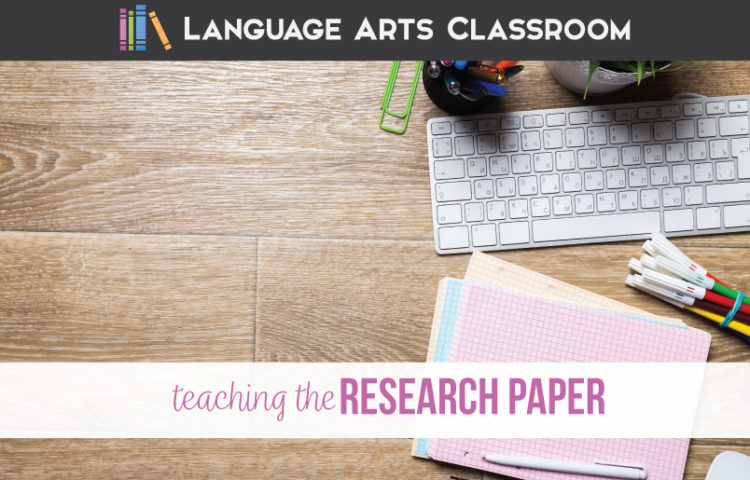
Teaching research papers with high school students? Teaching students how to write a research paper is an important part of an ELA class. Here are guidelines to make this writing unit a success.

Lawyers, political organizers, advertisers, real estate agents: most jobs require ethical research and then a written report. As a citizen, I research concepts important to my community and family. As knowledge in our world grows, student will only have more reasons to be ethical digital citizens.
Providing students with a sustainable foundation is a humbling responsibility. Teachers know that teaching students how to write a research paper is important. While teaching students how to research, I share those sentiments with them. I want students to know I take research seriously, and my expectation is that they will as well. My research paper lesson plans take into account the seriousness of ethical research.

What is the best way to teach research papers to students?
The best way to teach research papers to students is by breaking down the process into manageable steps. Start with teaching them how to choose a topic, conduct research, and create an outline/list/graphic organizer. Then guide them in writing drafts, revising and editing their papers, and properly citing sources.
Even after teaching for a decade, I sometimes overwhelm myself with this duty. I handle teaching research papers with four ideas in my mind.
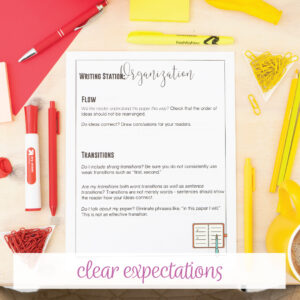
Provide clear expectations.
Idea one, be clear.
A feeling I always hated as a student was the unknown . Sure, part of the learning process is not knowing everything and making mistakes. I, as the teacher, don’t want to be the source of frustration though. I never want my classes to wander down a path that won’t advance them toward our end goal: a well-researched paper. Part of teaching research skills to high school students is providing clear expectations.
As writing in the ELA classroom becomes more digital, I simply give writers tools on our online learning platform. That way, I can remind them to check a certain section or page as we collaborate on their writing.

Give a writing overview.
Idea two, provide an overview.
Every teacher grades a little differently. Sometimes, terminology differs. Throw in the stress of research, and you might have a classroom of overwhelmed students. An overview before teaching research papers can relax everyone!
I start every writing unit with clear expectations, terminology, and goals. I cover a presentation with students, and then I upload it to Google Classroom. Students know to consult that presentation for clarity. Initially, covering the basics may seem wasteful, but it saves all of us time because students know my expectations.
Furthermore, parents and tutors appreciate my sharing that information. As students work independently (inside or outside of class), they can take it upon themselves to consult expectations. Their responsibility with this prepares them for their futures. Finally, having established that overview with students during virtual classes was invaluable.
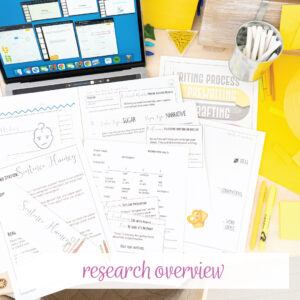
Show an overview of research.
Idea three, clearly explain research.
Before you begin teaching students how to research, outline what strong research looks like. You might consider these questions:
- What (if any) secondary sources will I accept? What about Wikipedia?
- Should students use a balance of books and online material? Do they have access to books?
- Are dates for certain topics important? Will I not accept research from before a certain date?
I’m not answering these questions for you, but I’ve seen teachers provide such guidelines while teaching research skills to high school students. Whatever parameters you have for teaching the research paper, share those with students.
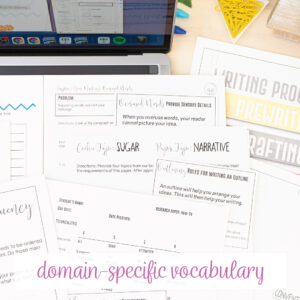
Define domain-specific vocabulary.
Idea four, don’t assume classes share the same domain-specific vocabulary.
High school classes are likely familiar with the writing process, yet the research process brings more vocabulary with which they might not be familiar.
Providing definitions for the most basic concepts enables me to walk through expectations and clarify concepts. Examples might include:
- Informational text
- Search engine
- Credible sources
- Claim, counterclaim
- Research question
- Journal articles
Plus, by providing definitions to terms, scaffolding occurs naturally. Academic writing has terms we teachers might use casually, but some students maybe have not heard of them.

How can we model ethical research?
After outlining expectations to young writers, we begin research. Some schools rely on Google Scholar, and others use Explora or EBSCO. Sign students into your databases, and run them through the program.
I stress to young writers that conducting oneself with honesty and integrity is crucial to writing. When teaching research papers with high school students, I connect these ethics to their very near futures. Aside from the basics of documenting and citing, I highlight these two points.

- Citing material. This includes direct quotes and paraphrasing. I review both of those concepts throughout our research and writing. The majority of a paper should be the writer’s thoughts, supported by research. Students need those concepts repeated, and they are important, so I spend time emphasizing them.
Often, I turn the basics of research into a writing mini lesson . Modeling ethical research is a very specific part of ELA classes. I understand that other classes require research and that parents might teach research skills as well.
Still, to have a functioning society, students must view relevant information with critical eyes. Teaching young citizens how to write a research paper includes clear guidelines for research and one-on-one conferencing.
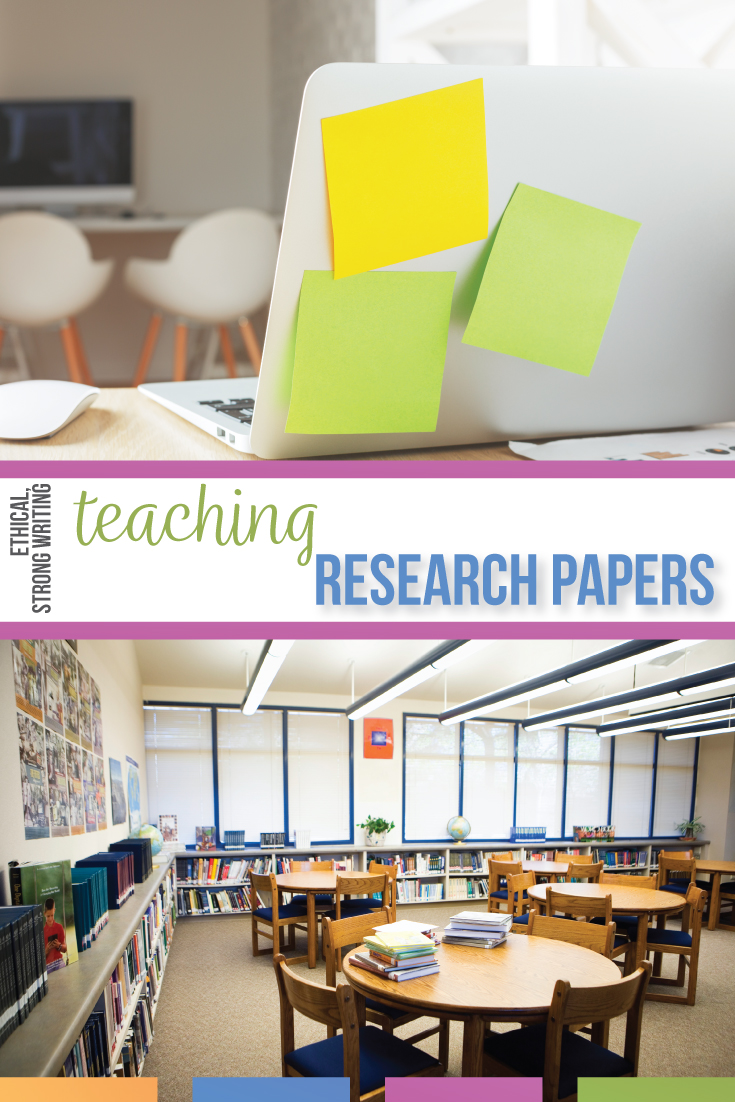
How can we encourage strong writing?
Hopefully, students write with passion. Hopefully, they want to show or prove their statements. Teaching students how to write a research paper is easier when students enjoy their topics.
I cover grammar with students (all year), and I always make the connection for them to implement those lessons. Teaching them to write a research paper requires some focus on writing skills. Primarily, they will work on strong verbs and syntax.

Look at verbs.
Students possess strong verbs in their vocabularies. Sometimes in writing, humans create a fast rough draft, myself included. Every verb is a linking verb, and every sentence reads subject + linking verb + predicate adjective. (Nothing is wrong with a linking verb, but writers should break from the mold.) When I see that a paper can be improved with strong verbs, we conference about ways to improve the verbs without thesaurus abuse.
Ask students to pick their least favorite paragraph in a research paper and to highlight every verb . Chances are, they are not conveying their message because of weak verbs. Help them turn the predicate adjectives into verbs or think of an action that will convey their meaning. Additionally as you continue teaching students how to research, you’ll cross strong verbs in research. Point out those verbs to your classes.

Examine syntax.
Just as every sentence shouldn’t contain a linking verb, not every sentence should be a simple sentence. Sentence syntax takes practice, and often teamwork! Ask students to provide a sentence that needs improvement. Break the sentence down into phrases and clauses. (If it is a simple sentence, ask for another sentence to attach.) What is the best arrangement? What is the student’s goal? Would a conjunctive adverb lead readers to a conclusion? What if a subordinating conjunction started the sentence, or, should the dependent clause come second in the complex sentence? Play with the language of papers! By connecting grammar to writing, you have empowered learners to improve their writing.
Sentence structure is also part of teaching students how to write a research paper because the information must be factual. Sometimes students report information incorrectly, and sometimes, their sentence structure is to blame. Focus on a return to simple syntax for ethical research, and then work on sentence diversity if possible.
All parts of an ELA classroom fit together like puzzle pieces, and when teaching research papers, that neatly assembled puzzle sits on display. By giving classes clear expectations, you are ready to guide them through ethical research and through strengthening their writing. Teaching the research paper is a large task, so you should know what you want to accomplish.
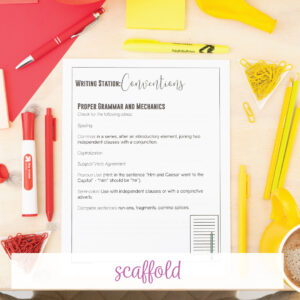
Is scaffolding teaching research papers possible?
Overall, a research unit takes me 2-3 weeks with high school students. Every teacher has different methodologies, but if I allow writing research papers for about a month, writers become bored. Fifteen working days for research, revision, and publishing is my average time frame. Going longer, and different aspects fall apart, and we lose momentum.
Scaffolding is built into our days. Outline the writing process with your calendar, and add days that follow the writing process. Pieces to consider:
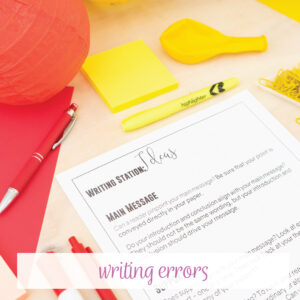
Scaffold writing errors.
Overall, writing errors are an inevitable part of the learning process. As teachers, it is crucial that we address these errors in a way that not only corrects them but also helps students understand why they occurred in the first place. When it comes to research papers, grammatical errors can significantly affect the credibility and clarity of the information presented.
One effective way to scaffold writing errors is by focusing on the actual problems that classes have in their papers. When we conference, I jot down common errors and then cover them as a class.
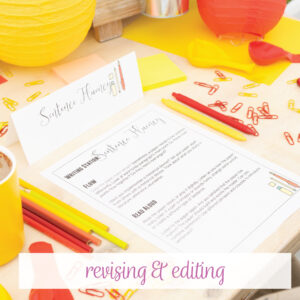
Include revising and editing days.
Young writers should take ownership of the writing process which includes revising and editing. This can be achieved by dedicating specific days in the research unit for revising and editing. By allotting time for these crucial steps, writers will learn to critically analyze their work and make necessary improvements.
During the revision phase, students can focus on the overall structure and organization of their research paper. They should evaluate if their arguments are clear and logical, if the evidence supports their claims effectively, and if there is a smooth flow of ideas throughout the paper. This stage allows them to refine their content and ensure that it aligns with their desired objectives.
After revising, students should move toward publishing and sharing with their peers.
Your turn, writing teachers: What questions do you have left?
All activities mentioned in this post (except the common errors bundle) are included in my writing bundle for freshmen and sophomores .
What questions remain? Do you have different advice to offer teachers?
What do you focus on with when teaching research papers? Read how Melissa from Reading and Writing Haven differentiates when teaching research writing .
Subscribe to our mailing list to receive updates about new blog posts, freebies, and teaching resources!
Marketing Permissions We will send you emails, but we will never sell your address.
You can change your mind at any time by clicking the unsubscribe link in the footer of any email you receive from us, or by contacting us at [email protected] . We will treat your information with respect. For more information about our privacy practices please visit our website. By clicking below, you agree that we may process your information in accordance with these terms.
We use Mailchimp as our marketing platform. By clicking below to subscribe, you acknowledge that your information will be transferred to Mailchimp for processing. Learn more about Mailchimp’s privacy practices here.

ethical research writing activities writing lessons writing process

Writing Research Papers
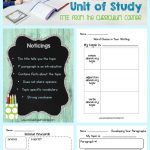
This research writing unit of study is designed to guide your students through the research writing process.
This is a free writing unit of study from the curriculum corner..
This research writing collection includes mini lessons, anchor charts and more.
Mention the words “research writing” in an intermediate classroom and you might be met with moans & groans or perhaps even see fear in the eyes of some students.
In all seriousness though, writing can be intimidating for many children in our classrooms.
Guided and focused your mini-lessons can be helpful for students. Also, the more examples you can get students to interact with, the more they will understand the expectations. Finally, the more modeling that you do for them, the more they can view writing as less overwhelming.
Download the free resources to accompany this unit of study at the bottom of this post.
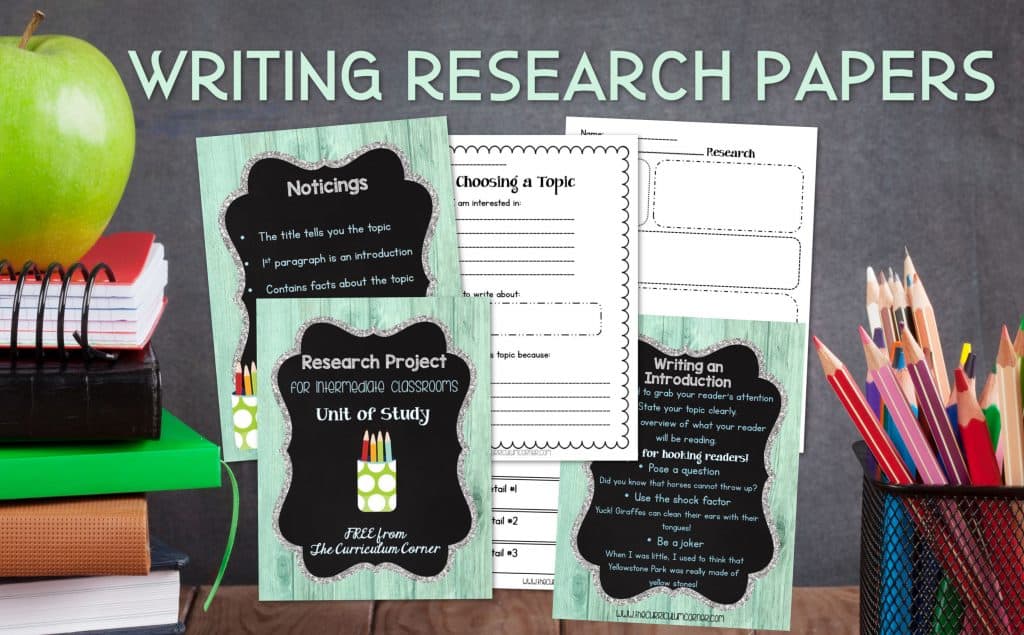
Lesson Ideas for Writing Research Papers:
Lesson 1: Noticings
- Begin by getting your students familiar with what research writing looks like.
- Have them work in pairs or small groups to read pieces of research writing. They will record their “noticings” about the writing.
- Then, come together in a community circle to discuss and create a class anchor chart.
- You will find a blank anchor chart and one with noticings already recorded.
- Here is a link we found that contains some student-created examples of research writing: Student Writing Models . Simply scroll through the grade levels for different samples.
Lesson 2: Opinion vs. Facts
- Begin with a brief review of opinions vs. facts.
- Use the six paragraphs we share in our resources to give your students some practice differentiating between the two.
- Each of the paragraphs contains both opinions and facts.
- Students will read the paragraphs and record the facts and opinions from their paragraph onto the recording page.
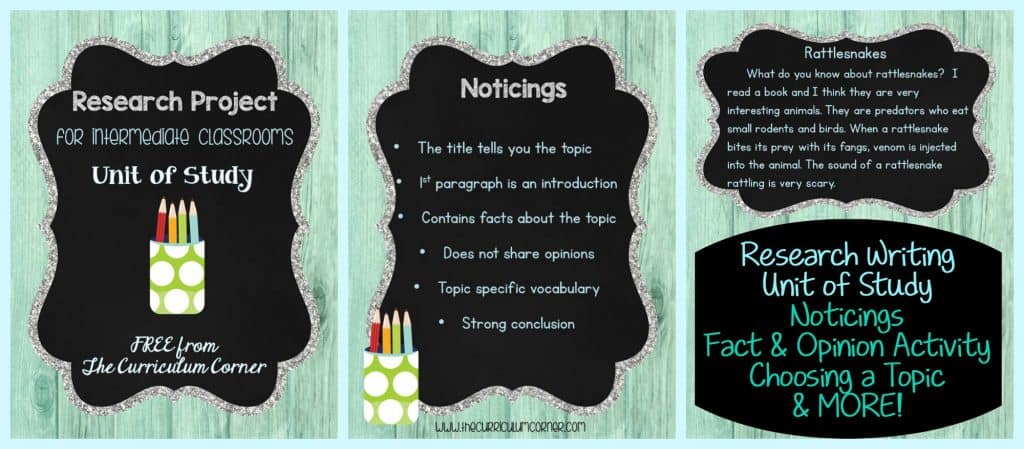
Lesson 3: Choosing a Topic
- We know that providing choice will allow for greater engagement and success. We want to help students to narrow their choices by giving them some guidance.
- Gather students and begin a discussion about choosing a research topic.
- Ask them to think of topics they already know a little about, have interest in or is important/relevant to their lives.
- You might pose the question “Why is that important in research writing?” and discuss their thoughts.
- For this lesson we have provided a page where students can individually brainstorm topics. You can circulate the room during this process to help students to narrow their topic.
- If you feel your class may need help to narrow their choices, think about giving them a broad topic, such as animals, and then have them choose a sub-topics from the bigger umbrella topic.
- If you feel like your students need an added level of support you might think about creating an anchor chart from a class brainstorming session about possible appropriate topics and then display this in your room.
Lesson 4: Where to Find Accurate Information about a Topic
- Help students to begin to understand where they might find accurate information about their topics.
- Where are the places you can begin to look for information about your topic?
- Why would the copyright date on a book be important in doing research?
- Is everything on the internet true?
- Why is it important for your research to contain accurate information?
- Where do you begin to look for information that will accurate
- One way to help students think through appropriate sites on the internet is to pass out the ten cards provided in our resources.
- Have students read the cards and discuss what kind of a website it is.
- Talk about whether they know or have heard of the sites. Would they consider the sites “trusted” enough to gain knowledge about their topics. Then have them talk about why or why not these sites would be trusted.
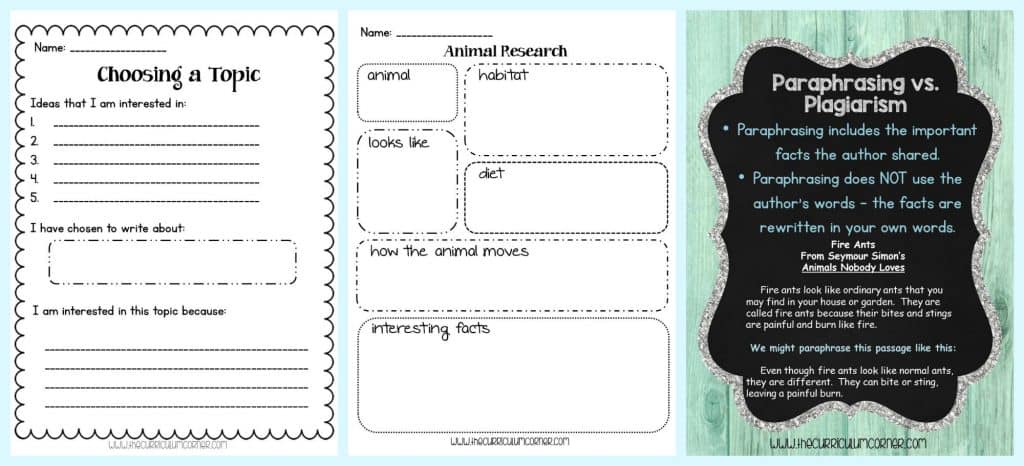
Lesson 5: Double Check Your Facts
- We want our students to get into the habit of double checking their facts. This will help ensure what they are learning is correct.
- To do this, you might want them to practice this skill. In this lesson use the page provided to have each student find and record a fact about a topic of their choice on the internet.
- The page then has students write where they found the fact, and also has them list a corresponding fact from a different source.
- Finally they determine if the facts are the same or different. You may have to further the lesson by discussing approximations. For example one site might say that an animal can weigh up to 1,500 pounds, while another might state that the animal weighs between 1,200 and 1,500 pounds.
- You will need to talk about how those facts might both be accurate even though they are stated differently. If they seem to check out, then help students generalize the information for a research paper.
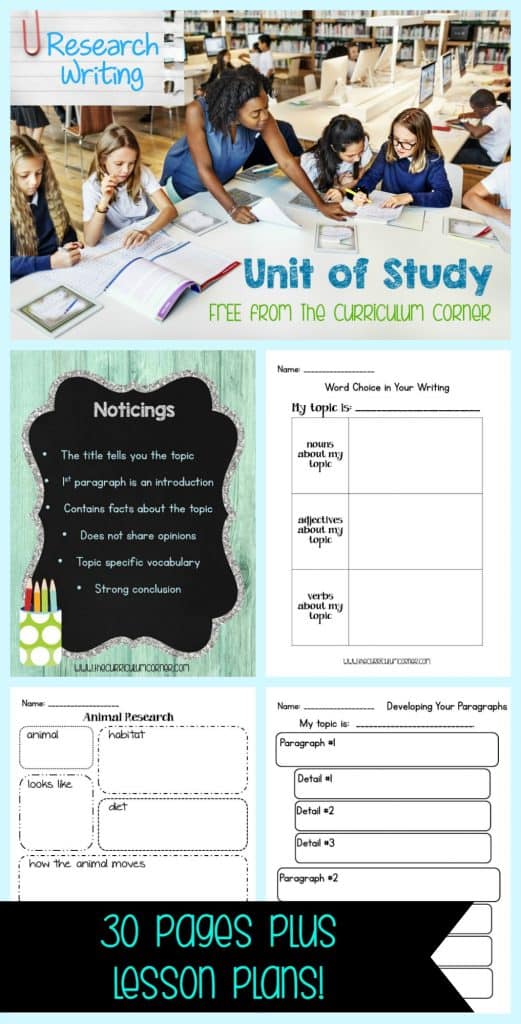
Lesson 6: Taking Notes
- Sometimes giving students resources and a blank sheet of notebook paper can be too overwhelming. You have students who simply copy everything from the text or you have others who have no idea where to start.
- We need to guide them to read to pull out facts & relevant information.
- For this lesson we have provided various templates for note-taking. Whatever method or template you choose for helping your students learn to take notes, model it several times in front of the class Demonstrating for them how to write the notes as they read about a topic will be helpful.
- After initial teaching, you may find that you need to pull small groups for extra practice. Some might need a one-on-one conference.
Lesson 7: Paraphrasing vs. Plagiarism
- Students will need to learn how to paraphrase their research. This will help them avoid plagiarizing words from their resources.
- Discuss why plagiarizing is something that they shouldn’t do in their writing because it is “stealing” another’s words.
- Tell the students that there is a way to use another author’s ideas in an appropriate way without copying their words. First, they need to paraphrase and then they need to cite the source where they found the information.
- Display the anchor chart “What is Paraphrasing” and discuss the definition.
- Next, pass out copies of “My Own Words” to pairs of students. Explain that their task will be to find a paragraph or passage in a nonfiction book. They will paraphrase the author’s words, keeping the same ideas.
- Finally, gather students together to share their paraphrasing efforts. Each pair of students can read the paragraph/passage from the book and then the paraphrasing that they wrote. Discuss the words and decisions the students made in their paraphrasing.
Lesson 8: Word Choice in Research Writing
- To help students think about making their writing more interesting, have them brainstorm words that could add voice to their writing.
- After working independently on the word choice page provided, have them meet with partners. They can talk about nouns, verbs and adjectives that relate to their topic.
Lesson 9: Writing Sketch
- This graphic organizer can be used for students to plan their writing.
- If your writers are more advanced you might choose to skip this step, It could be a big help for students who have taken notes and have too many facts.
- Be sure to model how to write the facts & ideas from your notes onto your planner. Students will see first hand how to make sure to only add what is relevant and important to their writing.
- Some questions you can pose: What will be the focus of each paragraph in your research writing? What do you want to include from your notes? Why is it important to the research? What facts don’t quite fit into the paragraphs you’ve decided upon? Should you change some of the paragraphs so that they better support the research and what you want your readers to learn?
- Once the planner is finished, they can use it as a guide to help their writing stay focused.
Lesson 10: Writing Introductions to Research
- Teach students how to think about their introduction as a way to grab their readers’ attention.
- Our anchor chart has some ideas to get writers started. You might also extend the anchor chart to include ideas from your students. (We have included some blank anchor charts at the very bottom of the download.)
- Discuss the parts that need to be included in the introductory paragraph first. Then, move on to some of the ways that might engage readers. As always be sure to model how you would go about writing an introductory paragraph using your Writing Sketch.
Lesson 11: Developing Your Paragraphs
- Next, help students stay focused and develop complete paragraphs.The next graphic organizer will get them to think through the specifics of each paragraph.
- Again, this may not be needed for all of the students in your classroom, but it might be something to think about using with all of them for at least their very first attempts at writing research papers.
- Model how to use the Writing Sketch planner to develop their paragraphs more fully on this organizer.
Lesson 12: Writing a Conclusion to Research
Providing a solid concluding paragraph is also something that needs modeled for your students.
Use the anchor chart with ideas to get you started with the modeling of this as well.
***If you would like for your students to write their first drafts on something that continues to support organization for them, you will find guided lined paper.
Lesson 13: Research Rendezvous Celebration
We love ending a unit of study with a celebration.
For this particular celebration, you might invite students to bring in a visual to help illustrate their topic.
Invite parents and other special adults from your building to the celebration and think about providing a snack.
You can also print out our “Congrats Author!” certificates to give to each student during the celebration.
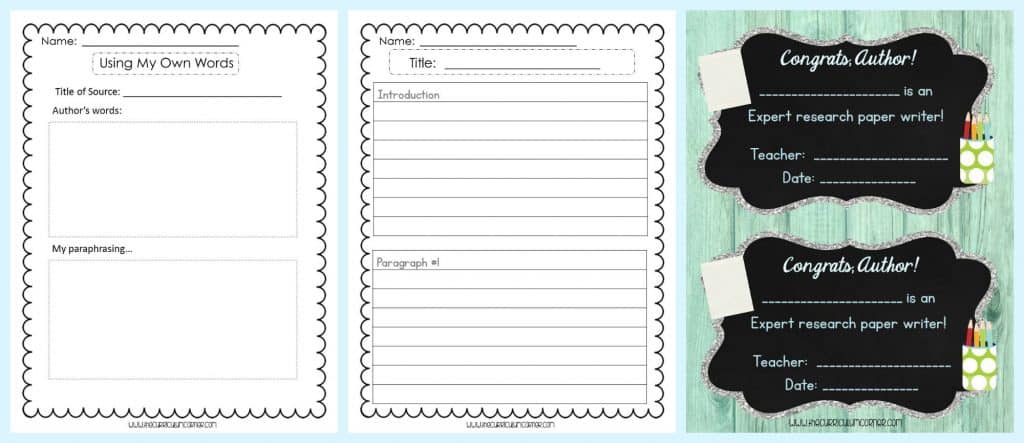
All the research writing resources described above can be found in one download here:
Writing a Research Paper Resources
As with all of our resources, The Curriculum Corner creates these for free classroom use. Our products may not be sold. You may print and copy for your personal classroom use. These are also great for home school families!
You may not modify and resell in any form. Please let us know if you have any questions.
Dulce Hernandez
Thursday 8th of April 2021
Thank you so much. I tutor non-English speakers from K-9th grade. These resources are a God send!!
Monday 25th of May 2020
I cant download it, where do you download it?
Jill & Cathy
Wednesday 2nd of September 2020
Here is the link: https://www.thecurriculumcorner.com/thecurriculumcorner456/wp-content/pdf/writing/research/researchwriting.pdf
Graphic Organizer for Research Papers - The Curriculum Corner 4-5-6
Tuesday 19th of November 2019
[…] You might also like our unit of study for writing research papers:How to Write a Research Paper […]
Planning a Dynamic Writing Workshop - The Curriculum Corner 123
Thursday 14th of November 2019
[…] Writing Research Papers […]
Language Arts in the Middle School and High School Years
Thursday 11th of May 2017
[…] The middle school years can also be a good time to introduce writing a short research paper if your student is ready. Introduce how to do research, how to make an outline, and how to write a short research paper, including how to cite sources. Here’s a website that has a free introduction to writing research papers: https://www.thecurriculumcorner.com/thecurriculumcorner456/writing-research-papers/. […]
Engage Every Learner.®

- Facebook Page - VariQuest
- Twitter - All Tweets
- Youtube - All Videos
- VariQuest Blog
[Lesson Plan] How to Write a Research Paper: The Research Process
- Share this Article

Research-writing has changed a lot over the years, and with the prominence of artificial intelligence, those changes are only going to continue.
As students learn the important skill of responsibly researching for their writing, we at VariQuest have put together a 42-page booklet, split into two parts (to make it easier to digest and teach!) and this first part focuses on the research portion of the process.
From choosing a topic, to learning to paraphrase, to writing a thesis, these lessons are designed in a writers'-workshop-style to immerse students in every important step of writing a research paper. Using the example of The Great Barrier Reef, each lesson is paired with a handful of helpful printables - including anchor charts, discussion-prompts, and more!
Previous Article
![lesson plan on writing a research paper [Lesson Plan] How to Write a Research Paper: The Writing Process](https://content.cdntwrk.com/mediaproxy?url=https%3A%2F%2Finfo.variquest.com%2Fhubfs%2FeBook%2FHow%2520to%2520Write%2520a%2520Research%2520Paper%2Fhow%2520to%2520write%2520a%2520research%2520paper%2520part%25202%2520blog%2520header.png%23keepProtocol&size=1&version=1708632756&sig=7a7f992b8eb3202d5b559b3528dee055&default=hubs%2Ftilebg-blogs.jpg)
We ask Google, we ask Alexa, we ask Siri...but what questions and answers do we need to find, ours...
Next Article
![lesson plan on writing a research paper [Lesson Plan] Artificial Intelligence for the Writing Classroom](https://content.cdntwrk.com/mediaproxy?url=https%3A%2F%2Finfo.variquest.com%2Fhubfs%2FeBook%2FHow%2520to%2520Write%2520a%2520Research%2520Paper%2Fartificial%2520intelligence%2520writing%2520classroom%2520blog%2520header.png%23keepProtocol&size=1&version=1708632757&sig=1c98b19f762d343b74c8fc180604f91f&default=hubs%2Ftilebg-blogs.jpg)
There are so many questions when it comes to Artificial Intelligence (AI) and how it will affect h...
Most Recent Articles

In the ever-evolving education landscape, innovation is key to engaging students and facilitating effective learning experiences. That's why VariQuest presents the Cutout Maker 1800...

The latest addition to the VariQuest suite of solutions provides endless options for creating on-the-spot school-wide communication, recognition, and student engagement...

Teacher Appreciation Week 2024 is May 6th-10th and while we at VariQuest appreciate teachers every day, many stores and restaurants give special recognition and discounts to our nation's...
![lesson plan on writing a research paper [Lesson Plan] Arbor Day Activities for Grades 4-6](https://content.cdntwrk.com/mediaproxy?url=https%3A%2F%2Finfo.variquest.com%2Fhubfs%2FLesson_Plan_PDFs%2Farbor%2520day%2520activities%2520blog%2520header.png%23keepProtocol&size=1&version=1713281322&sig=fa93c6558caab80b84ee1b7a3f74e75c&default=hubs%2Ftilebg-blogs.jpg)
Trees are good for the air we breathe, the water we drink, and among many other environmentally-beneficial qualities, they are important to many cultures in bringing people together....
![lesson plan on writing a research paper [Lesson Plan] SEL Photo Activities for Grades 5-7](https://content.cdntwrk.com/mediaproxy?url=https%3A%2F%2Finfo.variquest.com%2Fhubfs%2FLesson_Plan_PDFs%2FSEL%2520Photo%2520Activities%2520header.png%23keepProtocol&size=1&version=1712432018&sig=36043467659cdc58fd01a7c4e0b4e10f&default=hubs%2Ftilebg-blogs.jpg)
At a time when our world and nation are struggling with division and conflicting ideology - empathy and compassion are important concepts to teach our future generations, so they can...
![lesson plan on writing a research paper [Lesson Plan] Pi Day Activities for Upper-Elementary and Middle School Students](https://content.cdntwrk.com/mediaproxy?url=https%3A%2F%2Finfo.variquest.com%2Fhubfs%2FLesson_Plan_PDFs%2FPi%2520Day%2520Activities%2520Blog%2520Header.png%23keepProtocol&size=1&version=1710189992&sig=ab49c07260f67fe83b83f01a871ed392&default=hubs%2Ftilebg-blogs.jpg)
Circumference, diameter, radius, apple, cherry, rhubarb?! "Pi Day" is celebrated annually on March 14th (Get it - 3.14?!) and we're here to help you celebrate! According to piday.org,...

According to Neil Fleming's popular "VARK" model of learning types/styles, there are 4 main learning styles - including visual, auditory, reading/writing, and kinesthetic. Other models...
![lesson plan on writing a research paper [Lesson Plan] Menu Math for Grades 3-6](https://content.cdntwrk.com/mediaproxy?url=https%3A%2F%2Finfo.variquest.com%2Fhubfs%2FHeader%2520Images%2Fmenu%2520math%2520header.png%23keepProtocol&size=1&version=1708632754&sig=fc5bd7de33f25f58a6ff8d497a3d009e&default=hubs%2Ftilebg-blogs.jpg)
Real-world-application learning is where learning takes real flight! We're so proud when our students master a concept, but even more proud when they can apply it to their everyday lives....
![lesson plan on writing a research paper [Lesson Plan] Celebrate the Chinese New Year 2024!](https://content.cdntwrk.com/mediaproxy?url=https%3A%2F%2Finfo.variquest.com%2Fhubfs%2FCarman%2FCNY%25201-2018%2F%25E6%2581%25AD%25E5%2596%259C%25E7%2599%25BC%25E8%25B2%25A1.png%23keepProtocol&size=1&version=1708632755&sig=962e55db413d547df717013426c08ef8&default=hubs%2Ftilebg-blogs.jpg)
Chinese New Year, also known as the Spring Festival, has been celebrated for thousands of years. It is one of the most important holidays widely celebrated in many Asian countries and...
![lesson plan on writing a research paper [Free Holiday Printables] You've Been SOCKED!](https://content.cdntwrk.com/mediaproxy?url=https%3A%2F%2Finfo.variquest.com%2Fhubfs%2FHeader%2520Images%2Fyouve%2520been%2520socked%2520blog%2520header.png%23keepProtocol&size=1&version=1708632755&sig=fe271a837ddc50d0b0edfaa323d32280&default=hubs%2Ftilebg-blogs.jpg)
While everyone has different holiday traditions and celebrates this time of year in different ways - we can all agree that spreading kindness and joy is one of the best! We've put...
We ask google, we ask alexa, we ask siri...but what questions and answers do we need to find, ourselves the skill of writing a research paper doesn't just develop writing skills or..., there are so many questions when it comes to artificial intelligence (ai) and how it will affect humankind in the future. at its best, it can help us learn and understand even more about....
![lesson plan on writing a research paper [Downloads] Classroom Coloring Activities for Fall Holidays](https://content.cdntwrk.com/mediaproxy?url=https%3A%2F%2Finfo.variquest.com%2Fhubfs%2Ffall%2520coloring%2520blog%2520header.png%23keepProtocol&size=1&version=1708632757&sig=d3323da683a8b5bf05557420031fd2e5&default=hubs%2Ftilebg-blogs.jpg)
When the season of fall arrives, you're celebrating being done with the first few weeks of the school year, and outside the colors of the environment are changing. What better way to...

Trying to figure out how to best spend your Career & Technical Education funding - or use other funding for career & technical education programs? Let's take a look at some options.

Sensory paths are not only fun for elementary education because they help get the wiggles out, but they help with learning too! At VariQuest®, we feel passionately about visual and...
![lesson plan on writing a research paper [Lesson Plan] Building Community With Kindness](https://content.cdntwrk.com/mediaproxy?url=https%3A%2F%2Finfo.variquest.com%2Fhubfs%2FHeader%2520Images%2Fbuilding%2520community%2520with%2520kindness%2520email%2520header.png%23keepProtocol&size=1&version=1692198532&sig=78399484e4c0b8174887d25918c70a9c&default=hubs%2Ftilebg-blogs.jpg)
In the 1960s, The Beach Boys scored a hit with the song, Be True to Your School about being proud of the school you go to and defending it to others. Are you proud of the school you...
![lesson plan on writing a research paper [Download] Engage Every Learner® Content Fall 2023 Expansion Pack](https://content.cdntwrk.com/mediaproxy?url=https%3A%2F%2Finfo.variquest.com%2Fhubfs%2Fimages%2FeContent%2520Screenshots%2FFall%25202023%2520Release%2520Banner%25201200X400.png%23keepProtocol&size=1&version=1691693048&sig=27c99d424a13eed4e3bc55ebd2ca7b92&default=hubs%2Ftilebg-blogs.jpg)
We're deep into the back-to-school season, which means you're making your plans for the year - and as we do every spring and fall, we're bringing you a brand new expansion pack for your...
![lesson plan on writing a research paper [Printable] My Logins and References Notebook Inserts](https://content.cdntwrk.com/mediaproxy?url=https%3A%2F%2Finfo.variquest.com%2Fhubfs%2FHeader%2520Images%2Fmy%2520logins%2520and%2520references%2520blog%2520header.png%23keepProtocol&size=1&version=1689778862&sig=e728eacac23bc55826da0f1cd1af5247&default=hubs%2Ftilebg-blogs.jpg)
In this midst of the back-to-school shopping season, teachers, parents, and students alike are purchasing tools they will need to be successful in the coming school year. And using...

You can't escape reading about Artificial Intelligence (AI) advancements and how they are changing the world every day. From self-driving cars to robotics to digital assistants and...
![lesson plan on writing a research paper [Download] Writing With Caution Classroom Poster and Activities](https://content.cdntwrk.com/mediaproxy?url=https%3A%2F%2Finfo.variquest.com%2Fhubfs%2FHeader%2520Images%2Fwriting%2520with%2520caution%2520poster%2520header.png%23keepProtocol&size=1&version=1686837986&sig=38d5bd4d93ebd2148488bd7c71770535&default=hubs%2Ftilebg-blogs.jpg)
THERE (not their, or they're) is no way around it - homophones are tricky...and the English language is full of them!
- Share this Hub

- Ask LitCharts AI
- Discussion Question Generator
- Essay Prompt Generator
- Quiz Question Generator

- Literature Guides
- Poetry Guides
- Shakespeare Translations
- Literary Terms
How to Write a Research Paper
Use the links below to jump directly to any section of this guide:
Research Paper Fundamentals
How to choose a topic or question, how to create a working hypothesis or thesis, common research paper methodologies, how to gather and organize evidence , how to write an outline for your research paper, how to write a rough draft, how to revise your draft, how to produce a final draft, resources for teachers .
It is not fair to say that no one writes anymore. Just about everyone writes text messages, brief emails, or social media posts every single day. Yet, most people don't have a lot of practice with the formal, organized writing required for a good academic research paper. This guide contains links to a variety of resources that can help demystify the process. Some of these resources are intended for teachers; they contain exercises, activities, and teaching strategies. Other resources are intended for direct use by students who are struggling to write papers, or are looking for tips to make the process go more smoothly.
The resources in this section are designed to help students understand the different types of research papers, the general research process, and how to manage their time. Below, you'll find links from university writing centers, the trusted Purdue Online Writing Lab, and more.
What is an Academic Research Paper?
"Genre and the Research Paper" (Purdue OWL)
There are different types of research papers. Different types of scholarly questions will lend themselves to one format or another. This is a brief introduction to the two main genres of research paper: analytic and argumentative.
"7 Most Popular Types of Research Papers" (Personal-writer.com)
This resource discusses formats that high school students commonly encounter, such as the compare and contrast essay and the definitional essay. Please note that the inclusion of this link is not an endorsement of this company's paid service.
How to Prepare and Plan Out Writing a Research Paper
Teachers can give their students a step-by-step guide like these to help them understand the different steps of the research paper process. These guides can be combined with the time management tools in the next subsection to help students come up with customized calendars for completing their papers.
"Ten Steps for Writing Research Papers" (American University)
This resource from American University is a comprehensive guide to the research paper writing process, and includes examples of proper research questions and thesis topics.
"Steps in Writing a Research Paper" (SUNY Empire State College)
This guide breaks the research paper process into 11 steps. Each "step" links to a separate page, which describes the work entailed in completing it.
How to Manage Time Effectively
The links below will help students determine how much time is necessary to complete a paper. If your sources are not available online or at your local library, you'll need to leave extra time for the Interlibrary Loan process. Remember that, even if you do not need to consult secondary sources, you'll still need to leave yourself ample time to organize your thoughts.
"Research Paper Planner: Timeline" (Baylor University)
This interactive resource from Baylor University creates a suggested writing schedule based on how much time a student has to work on the assignment.
"Research Paper Planner" (UCLA)
UCLA's library offers this step-by-step guide to the research paper writing process, which also includes a suggested planning calendar.
There's a reason teachers spend a long time talking about choosing a good topic. Without a good topic and a well-formulated research question, it is almost impossible to write a clear and organized paper. The resources below will help you generate ideas and formulate precise questions.
"How to Select a Research Topic" (Univ. of Michigan-Flint)
This resource is designed for college students who are struggling to come up with an appropriate topic. A student who uses this resource and still feels unsure about his or her topic should consult the course instructor for further personalized assistance.
"25 Interesting Research Paper Topics to Get You Started" (Kibin)
This resource, which is probably most appropriate for high school students, provides a list of specific topics to help get students started. It is broken into subsections, such as "paper topics on local issues."
"Writing a Good Research Question" (Grand Canyon University)
This introduction to research questions includes some embedded videos, as well as links to scholarly articles on research questions. This resource would be most appropriate for teachers who are planning lessons on research paper fundamentals.
"How to Write a Research Question the Right Way" (Kibin)
This student-focused resource provides more detail on writing research questions. The language is accessible, and there are embedded videos and examples of good and bad questions.
It is important to have a rough hypothesis or thesis in mind at the beginning of the research process. People who have a sense of what they want to say will have an easier time sorting through scholarly sources and other information. The key, of course, is not to become too wedded to the draft hypothesis or thesis. Just about every working thesis gets changed during the research process.
CrashCourse Video: "Sociology Research Methods" (YouTube)
Although this video is tailored to sociology students, it is applicable to students in a variety of social science disciplines. This video does a good job demonstrating the connection between the brainstorming that goes into selecting a research question and the formulation of a working hypothesis.
"How to Write a Thesis Statement for an Analytical Essay" (YouTube)
Students writing analytical essays will not develop the same type of working hypothesis as students who are writing research papers in other disciplines. For these students, developing the working thesis may happen as a part of the rough draft (see the relevant section below).
"Research Hypothesis" (Oakland Univ.)
This resource provides some examples of hypotheses in social science disciplines like Political Science and Criminal Justice. These sample hypotheses may also be useful for students in other soft social sciences and humanities disciplines like History.
When grading a research paper, instructors look for a consistent methodology. This section will help you understand different methodological approaches used in research papers. Students will get the most out of these resources if they use them to help prepare for conversations with teachers or discussions in class.
"Types of Research Designs" (USC)
A "research design," used for complex papers, is related to the paper's method. This resource contains introductions to a variety of popular research designs in the social sciences. Although it is not the most intuitive site to read, the information here is very valuable.
"Major Research Methods" (YouTube)
Although this video is a bit on the dry side, it provides a comprehensive overview of the major research methodologies in a format that might be more accessible to students who have struggled with textbooks or other written resources.
"Humanities Research Strategies" (USC)
This is a portal where students can learn about four methodological approaches for humanities papers: Historical Methodologies, Textual Criticism, Conceptual Analysis, and the Synoptic method.
"Selected Major Social Science Research Methods: Overview" (National Academies Press)
This appendix from the book Using Science as Evidence in Public Policy , printed by National Academies Press, introduces some methods used in social science papers.
"Organizing Your Social Sciences Research Paper: 6. The Methodology" (USC)
This resource from the University of Southern California's library contains tips for writing a methodology section in a research paper.
How to Determine the Best Methodology for You
Anyone who is new to writing research papers should be sure to select a method in consultation with their instructor. These resources can be used to help prepare for that discussion. They may also be used on their own by more advanced students.
"Choosing Appropriate Research Methodologies" (Palgrave Study Skills)
This friendly and approachable resource from Palgrave Macmillan can be used by students who are just starting to think about appropriate methodologies.
"How to Choose Your Research Methods" (NFER (UK))
This is another approachable resource students can use to help narrow down the most appropriate methods for their research projects.
The resources in this section introduce the process of gathering scholarly sources and collecting evidence. You'll find a range of material here, from introductory guides to advanced explications best suited to college students. Please consult the LitCharts How to Do Academic Research guide for a more comprehensive list of resources devoted to finding scholarly literature.
Google Scholar
Students who have access to library websites with detailed research guides should start there, but people who do not have access to those resources can begin their search for secondary literature here.
"Gathering Appropriate Information" (Texas Gateway)
This resource from the Texas Gateway for online resources introduces students to the research process, and contains interactive exercises. The level of complexity is suitable for middle school, high school, and introductory college classrooms.
"An Overview of Quantitative and Qualitative Data Collection Methods" (NSF)
This PDF from the National Science Foundation goes into detail about best practices and pitfalls in data collection across multiple types of methodologies.
"Social Science Methods for Data Collection and Analysis" (Swiss FIT)
This resource is appropriate for advanced undergraduates or teachers looking to create lessons on research design and data collection. It covers techniques for gathering data via interviews, observations, and other methods.
"Collecting Data by In-depth Interviewing" (Leeds Univ.)
This resource contains enough information about conducting interviews to make it useful for teachers who want to create a lesson plan, but is also accessible enough for college juniors or seniors to make use of it on their own.
There is no "one size fits all" outlining technique. Some students might devote all their energy and attention to the outline in order to avoid the paper. Other students may benefit from being made to sit down and organize their thoughts into a lengthy sentence outline. The resources in this section include strategies and templates for multiple types of outlines.
"Topic vs. Sentence Outlines" (UC Berkeley)
This resource introduces two basic approaches to outlining: the shorter topic-based approach, and the longer, more detailed sentence-based approach. This resource also contains videos on how to develop paper paragraphs from the sentence-based outline.
"Types of Outlines and Samples" (Purdue OWL)
The Purdue Online Writing Lab's guide is a slightly less detailed discussion of different types of outlines. It contains several sample outlines.
"Writing An Outline" (Austin C.C.)
This resource from a community college contains sample outlines from an American history class that students can use as models.
"How to Structure an Outline for a College Paper" (YouTube)
This brief (sub-2 minute) video from the ExpertVillage YouTube channel provides a model of outline writing for students who are struggling with the idea.
"Outlining" (Harvard)
This is a good resource to consult after completing a draft outline. It offers suggestions for making sure your outline avoids things like unnecessary repetition.
As with outlines, rough drafts can take on many different forms. These resources introduce teachers and students to the various approaches to writing a rough draft. This section also includes resources that will help you cite your sources appropriately according to the MLA, Chicago, and APA style manuals.
"Creating a Rough Draft for a Research Paper" (Univ. of Minnesota)
This resource is useful for teachers in particular, as it provides some suggested exercises to help students with writing a basic rough draft.
Rough Draft Assignment (Duke of Definition)
This sample assignment, with a brief list of tips, was developed by a high school teacher who runs a very successful and well-reviewed page of educational resources.
"Creating the First Draft of Your Research Paper" (Concordia Univ.)
This resource will be helpful for perfectionists or procrastinators, as it opens by discussing the problem of avoiding writing. It also provides a short list of suggestions meant to get students writing.
Using Proper Citations
There is no such thing as a rough draft of a scholarly citation. These links to the three major citation guides will ensure that your citations follow the correct format. Please consult the LitCharts How to Cite Your Sources guide for more resources.
Chicago Manual of Style Citation Guide
Some call The Chicago Manual of Style , which was first published in 1906, "the editors' Bible." The manual is now in its 17th edition, and is popular in the social sciences, historical journals, and some other fields in the humanities.
APA Citation Guide
According to the American Psychological Association, this guide was developed to aid reading comprehension, clarity of communication, and to reduce bias in language in the social and behavioral sciences. Its first full edition was published in 1952, and it is now in its sixth edition.
MLA Citation Guide
The Modern Language Association style is used most commonly within the liberal arts and humanities. The MLA Style Manual and Guide to Scholarly Publishing was first published in 1985 and (as of 2008) is in its third edition.
Any professional scholar will tell you that the best research papers are made in the revision stage. No matter how strong your research question or working thesis, it is not possible to write a truly outstanding paper without devoting energy to revision. These resources provide examples of revision exercises for the classroom, as well as tips for students working independently.
"The Art of Revision" (Univ. of Arizona)
This resource provides a wealth of information and suggestions for both students and teachers. There is a list of suggested exercises that teachers might use in class, along with a revision checklist that is useful for teachers and students alike.
"Script for Workshop on Revision" (Vanderbilt University)
Vanderbilt's guide for leading a 50-minute revision workshop can serve as a model for teachers who wish to guide students through the revision process during classtime.
"Revising Your Paper" (Univ. of Washington)
This detailed handout was designed for students who are beginning the revision process. It discusses different approaches and methods for revision, and also includes a detailed list of things students should look for while they revise.
"Revising Drafts" (UNC Writing Center)
This resource is designed for students and suggests things to look for during the revision process. It provides steps for the process and has a FAQ for students who have questions about why it is important to revise.
Conferencing with Writing Tutors and Instructors
No writer is so good that he or she can't benefit from meeting with instructors or peer tutors. These resources from university writing, learning, and communication centers provide suggestions for how to get the most out of these one-on-one meetings.
"Getting Feedback" (UNC Writing Center)
This very helpful resource talks about how to ask for feedback during the entire writing process. It contains possible questions that students might ask when developing an outline, during the revision process, and after the final draft has been graded.
"Prepare for Your Tutoring Session" (Otis College of Art and Design)
This guide from a university's student learning center contains a lot of helpful tips for getting the most out of working with a writing tutor.
"The Importance of Asking Your Professor" (Univ. of Waterloo)
This article from the university's Writing and Communication Centre's blog contains some suggestions for how and when to get help from professors and Teaching Assistants.
Once you've revised your first draft, you're well on your way to handing in a polished paper. These resources—each of them produced by writing professionals at colleges and universities—outline the steps required in order to produce a final draft. You'll find proofreading tips and checklists in text and video form.
"Developing a Final Draft of a Research Paper" (Univ. of Minnesota)
While this resource contains suggestions for revision, it also features a couple of helpful checklists for the last stages of completing a final draft.
Basic Final Draft Tips and Checklist (Univ. of Maryland-University College)
This short and accessible resource, part of UMUC's very thorough online guide to writing and research, contains a very basic checklist for students who are getting ready to turn in their final drafts.
Final Draft Checklist (Everett C.C.)
This is another accessible final draft checklist, appropriate for both high school and college students. It suggests reading your essay aloud at least once.
"How to Proofread Your Final Draft" (YouTube)
This video (approximately 5 minutes), produced by Eastern Washington University, gives students tips on proofreading final drafts.
"Proofreading Tips" (Georgia Southern-Armstrong)
This guide will help students learn how to spot common errors in their papers. It suggests focusing on content and editing for grammar and mechanics.
This final set of resources is intended specifically for high school and college instructors. It provides links to unit plans and classroom exercises that can help improve students' research and writing skills. You'll find resources that give an overview of the process, along with activities that focus on how to begin and how to carry out research.
"Research Paper Complete Resources Pack" (Teachers Pay Teachers)
This packet of assignments, rubrics, and other resources is designed for high school students. The resources in this packet are aligned to Common Core standards.
"Research Paper—Complete Unit" (Teachers Pay Teachers)
This packet of assignments, notes, PowerPoints, and other resources has a 4/4 rating with over 700 ratings. It is designed for high school teachers, but might also be useful to college instructors who work with freshmen.
"Teaching Students to Write Good Papers" (Yale)
This resource from Yale's Center for Teaching and Learning is designed for college instructors, and it includes links to appropriate activities and exercises.
"Research Paper Writing: An Overview" (CUNY Brooklyn)
CUNY Brooklyn offers this complete lesson plan for introducing students to research papers. It includes an accompanying set of PowerPoint slides.
"Lesson Plan: How to Begin Writing a Research Paper" (San Jose State Univ.)
This lesson plan is designed for students in the health sciences, so teachers will have to modify it for their own needs. It includes a breakdown of the brainstorming, topic selection, and research question process.
"Quantitative Techniques for Social Science Research" (Univ. of Pittsburgh)
This is a set of PowerPoint slides that can be used to introduce students to a variety of quantitative methods used in the social sciences.
- PDFs for all 136 Lit Terms we cover
- Downloads of 1983 LitCharts Lit Guides
- Teacher Editions for every Lit Guide
- Explanations and citation info for 41,889 quotes across 1983 books
- Downloadable (PDF) line-by-line translations of every Shakespeare play
Need something? Request a new guide .
How can we improve? Share feedback .
LitCharts is hiring!

- Quizzes, saving guides, requests, plus so much more.
Jump to navigation
- Inside Writing
- Teacher's Guides
- Student Models
- Writing Topics
- Minilessons
- Shopping Cart
- Inside Grammar
- Grammar Adventures
- CCSS Correlations
- Infographics
Sign up or login to use the bookmarking feature.
Writing a Research Paper
After fully engaging your sources, you have plenty of remarkable information to convey to your reader. The problem may be figuring out where to begin. What do you share first?
The following activities will suggest many starting points and ending points and other points in between. The strategies below will prime the pump of your ideas, getting them to flow easily into your first draft.

Writing the Beginning Paragraph
Your first job in writing a research paper is to catch your reader's interest. You can experiment with a number of strategies to form an interesting lead sentence.
Write a lead sentence.
Try out some of these strategies for introducing your research paper. Read the examples for ideas. Make a copy of this Google doc or download a Word template .
"Do things. Be sane. Don't fritter away your time; create, act, take a place wherever you are, and be somebody; get action.” —Theodore Roosevelt, Sr.
Teddy Roosevelt transformed himself from an asthmatic weakling to a brawler who won in Cuba and Panama, in Washington and on Mount Rushmore.
As they charged up San Juan Hill into the teeth of machine-gun fire, Teddy Roosevelt turned to a fellow soldier and shouted, "Holy Godfrey, what fun!"
Are heroes born, or are they made?
© 2024 Thoughtful Learning. Copying is permitted.
k12.thoughtfullearning.com

Research Writing (Grades 4-6)
Our Research Writing lesson plan for grades 4-6 teaches students how to write a thoroughly researched and factually accurate five paragraph essay. Students write an essay based on research they conduct in order to practice this type of writing.
Description
Additional information.
Our Research Writing Lesson Plan for grades 4-6 teaches students about the importance of researching and reporting findings accurately and effectively. Being able to clearly and accurately inform and communicate findings through writing is a valuable skill that students will need in many areas of their lives. Gathering and summarizing key information will also be a powerful tool for academic reading and writing throughout upper grades and higher education. In this lesson, students are asked to use the information they have learned to research and write a research paper from start to finish, including brainstorming and outlining.
At the end of the lesson, students will have written an essay based on a topic of their choosing with sources cited.
| subject | Language Arts |
|---|---|
| grade-level | 4th Grade, 5th Grade, 6th Grade |
| State Educational Standards | LB.ELA-LITERACY.W.5.2.A |
Thank you for submitting a review!
Your input is very much appreciated. Share it with your friends so they can enjoy it too!
Great Resource
Awesome! I was encouraged to find this as I develop my own writing curriculum for my homeschooled middle schoolers.

Nice resource
I haven't used this resource yet, but at first glance it looks helpful!
Research Writing
I have not started this with my child yet, but I have looked over the information. I am really looking forward to using this. Very informative.
I absolutely love the blended
I absolutely love the blended lesson plan structure that accommodates for all types of learners. you all ROCK!!!
Excellent curriculum
Lots of subjects and ways to teach kids. Love the packets
Related products
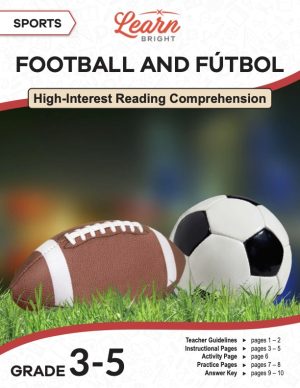
Sports: Football and Fútbol

Sports: Ice Hockey
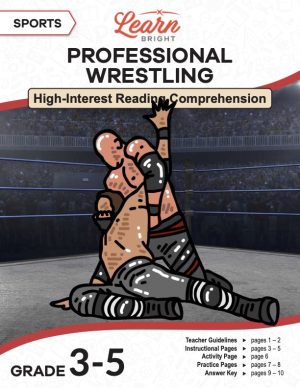
Sports: Professional Wrestling
Make your life easier with our lesson plans, stay up-to-date with new lessons.

- Lesson Plans
- For Teachers
© 2024 Learn Bright. All rights reserved. Terms and Conditions. Privacy Policy.
- Sign Up for Free
Writing Research Papers Lesson Plans
- Most Popular
- Most Recent
| Add to Folder | |
|---|---|
| creative writing | |
| children's book | |
| activities | |
| classroom tools | |
| language arts and writing | |
| vocabulary |

Have a language expert improve your writing
Run a free plagiarism check in 10 minutes, generate accurate citations for free.
- Knowledge Base
- Research paper
How to Write a Research Paper | A Beginner's Guide
A research paper is a piece of academic writing that provides analysis, interpretation, and argument based on in-depth independent research.
Research papers are similar to academic essays , but they are usually longer and more detailed assignments, designed to assess not only your writing skills but also your skills in scholarly research. Writing a research paper requires you to demonstrate a strong knowledge of your topic, engage with a variety of sources, and make an original contribution to the debate.
This step-by-step guide takes you through the entire writing process, from understanding your assignment to proofreading your final draft.
Instantly correct all language mistakes in your text
Upload your document to correct all your mistakes in minutes

Table of contents
Understand the assignment, choose a research paper topic, conduct preliminary research, develop a thesis statement, create a research paper outline, write a first draft of the research paper, write the introduction, write a compelling body of text, write the conclusion, the second draft, the revision process, research paper checklist, free lecture slides.
Completing a research paper successfully means accomplishing the specific tasks set out for you. Before you start, make sure you thoroughly understanding the assignment task sheet:
- Read it carefully, looking for anything confusing you might need to clarify with your professor.
- Identify the assignment goal, deadline, length specifications, formatting, and submission method.
- Make a bulleted list of the key points, then go back and cross completed items off as you’re writing.
Carefully consider your timeframe and word limit: be realistic, and plan enough time to research, write, and edit.
Scribbr Citation Checker New
The AI-powered Citation Checker helps you avoid common mistakes such as:
- Missing commas and periods
- Incorrect usage of “et al.”
- Ampersands (&) in narrative citations
- Missing reference entries

There are many ways to generate an idea for a research paper, from brainstorming with pen and paper to talking it through with a fellow student or professor.
You can try free writing, which involves taking a broad topic and writing continuously for two or three minutes to identify absolutely anything relevant that could be interesting.
You can also gain inspiration from other research. The discussion or recommendations sections of research papers often include ideas for other specific topics that require further examination.
Once you have a broad subject area, narrow it down to choose a topic that interests you, m eets the criteria of your assignment, and i s possible to research. Aim for ideas that are both original and specific:
- A paper following the chronology of World War II would not be original or specific enough.
- A paper on the experience of Danish citizens living close to the German border during World War II would be specific and could be original enough.
Note any discussions that seem important to the topic, and try to find an issue that you can focus your paper around. Use a variety of sources , including journals, books, and reliable websites, to ensure you do not miss anything glaring.
Do not only verify the ideas you have in mind, but look for sources that contradict your point of view.
- Is there anything people seem to overlook in the sources you research?
- Are there any heated debates you can address?
- Do you have a unique take on your topic?
- Have there been some recent developments that build on the extant research?
In this stage, you might find it helpful to formulate some research questions to help guide you. To write research questions, try to finish the following sentence: “I want to know how/what/why…”
A thesis statement is a statement of your central argument — it establishes the purpose and position of your paper. If you started with a research question, the thesis statement should answer it. It should also show what evidence and reasoning you’ll use to support that answer.
The thesis statement should be concise, contentious, and coherent. That means it should briefly summarize your argument in a sentence or two, make a claim that requires further evidence or analysis, and make a coherent point that relates to every part of the paper.
You will probably revise and refine the thesis statement as you do more research, but it can serve as a guide throughout the writing process. Every paragraph should aim to support and develop this central claim.
A research paper outline is essentially a list of the key topics, arguments, and evidence you want to include, divided into sections with headings so that you know roughly what the paper will look like before you start writing.
A structure outline can help make the writing process much more efficient, so it’s worth dedicating some time to create one.
Your first draft won’t be perfect — you can polish later on. Your priorities at this stage are as follows:
- Maintaining forward momentum — write now, perfect later.
- Paying attention to clear organization and logical ordering of paragraphs and sentences, which will help when you come to the second draft.
- Expressing your ideas as clearly as possible, so you know what you were trying to say when you come back to the text.
You do not need to start by writing the introduction. Begin where it feels most natural for you — some prefer to finish the most difficult sections first, while others choose to start with the easiest part. If you created an outline, use it as a map while you work.
Do not delete large sections of text. If you begin to dislike something you have written or find it doesn’t quite fit, move it to a different document, but don’t lose it completely — you never know if it might come in useful later.
Paragraph structure
Paragraphs are the basic building blocks of research papers. Each one should focus on a single claim or idea that helps to establish the overall argument or purpose of the paper.
Example paragraph
George Orwell’s 1946 essay “Politics and the English Language” has had an enduring impact on thought about the relationship between politics and language. This impact is particularly obvious in light of the various critical review articles that have recently referenced the essay. For example, consider Mark Falcoff’s 2009 article in The National Review Online, “The Perversion of Language; or, Orwell Revisited,” in which he analyzes several common words (“activist,” “civil-rights leader,” “diversity,” and more). Falcoff’s close analysis of the ambiguity built into political language intentionally mirrors Orwell’s own point-by-point analysis of the political language of his day. Even 63 years after its publication, Orwell’s essay is emulated by contemporary thinkers.
Citing sources
It’s also important to keep track of citations at this stage to avoid accidental plagiarism . Each time you use a source, make sure to take note of where the information came from.
You can use our free citation generators to automatically create citations and save your reference list as you go.
APA Citation Generator MLA Citation Generator
The research paper introduction should address three questions: What, why, and how? After finishing the introduction, the reader should know what the paper is about, why it is worth reading, and how you’ll build your arguments.
What? Be specific about the topic of the paper, introduce the background, and define key terms or concepts.
Why? This is the most important, but also the most difficult, part of the introduction. Try to provide brief answers to the following questions: What new material or insight are you offering? What important issues does your essay help define or answer?
How? To let the reader know what to expect from the rest of the paper, the introduction should include a “map” of what will be discussed, briefly presenting the key elements of the paper in chronological order.
The major struggle faced by most writers is how to organize the information presented in the paper, which is one reason an outline is so useful. However, remember that the outline is only a guide and, when writing, you can be flexible with the order in which the information and arguments are presented.
One way to stay on track is to use your thesis statement and topic sentences . Check:
- topic sentences against the thesis statement;
- topic sentences against each other, for similarities and logical ordering;
- and each sentence against the topic sentence of that paragraph.
Be aware of paragraphs that seem to cover the same things. If two paragraphs discuss something similar, they must approach that topic in different ways. Aim to create smooth transitions between sentences, paragraphs, and sections.
The research paper conclusion is designed to help your reader out of the paper’s argument, giving them a sense of finality.
Trace the course of the paper, emphasizing how it all comes together to prove your thesis statement. Give the paper a sense of finality by making sure the reader understands how you’ve settled the issues raised in the introduction.
You might also discuss the more general consequences of the argument, outline what the paper offers to future students of the topic, and suggest any questions the paper’s argument raises but cannot or does not try to answer.
You should not :
- Offer new arguments or essential information
- Take up any more space than necessary
- Begin with stock phrases that signal you are ending the paper (e.g. “In conclusion”)
There are four main considerations when it comes to the second draft.
- Check how your vision of the paper lines up with the first draft and, more importantly, that your paper still answers the assignment.
- Identify any assumptions that might require (more substantial) justification, keeping your reader’s perspective foremost in mind. Remove these points if you cannot substantiate them further.
- Be open to rearranging your ideas. Check whether any sections feel out of place and whether your ideas could be better organized.
- If you find that old ideas do not fit as well as you anticipated, you should cut them out or condense them. You might also find that new and well-suited ideas occurred to you during the writing of the first draft — now is the time to make them part of the paper.
The goal during the revision and proofreading process is to ensure you have completed all the necessary tasks and that the paper is as well-articulated as possible. You can speed up the proofreading process by using the AI proofreader .
Global concerns
- Confirm that your paper completes every task specified in your assignment sheet.
- Check for logical organization and flow of paragraphs.
- Check paragraphs against the introduction and thesis statement.
Fine-grained details
Check the content of each paragraph, making sure that:
- each sentence helps support the topic sentence.
- no unnecessary or irrelevant information is present.
- all technical terms your audience might not know are identified.
Next, think about sentence structure , grammatical errors, and formatting . Check that you have correctly used transition words and phrases to show the connections between your ideas. Look for typos, cut unnecessary words, and check for consistency in aspects such as heading formatting and spellings .
Finally, you need to make sure your paper is correctly formatted according to the rules of the citation style you are using. For example, you might need to include an MLA heading or create an APA title page .
Scribbr’s professional editors can help with the revision process with our award-winning proofreading services.
Discover our paper editing service
Checklist: Research paper
I have followed all instructions in the assignment sheet.
My introduction presents my topic in an engaging way and provides necessary background information.
My introduction presents a clear, focused research problem and/or thesis statement .
My paper is logically organized using paragraphs and (if relevant) section headings .
Each paragraph is clearly focused on one central idea, expressed in a clear topic sentence .
Each paragraph is relevant to my research problem or thesis statement.
I have used appropriate transitions to clarify the connections between sections, paragraphs, and sentences.
My conclusion provides a concise answer to the research question or emphasizes how the thesis has been supported.
My conclusion shows how my research has contributed to knowledge or understanding of my topic.
My conclusion does not present any new points or information essential to my argument.
I have provided an in-text citation every time I refer to ideas or information from a source.
I have included a reference list at the end of my paper, consistently formatted according to a specific citation style .
I have thoroughly revised my paper and addressed any feedback from my professor or supervisor.
I have followed all formatting guidelines (page numbers, headers, spacing, etc.).
You've written a great paper. Make sure it's perfect with the help of a Scribbr editor!
Open Google Slides Download PowerPoint
Is this article helpful?
Other students also liked.
- Writing a Research Paper Introduction | Step-by-Step Guide
- Writing a Research Paper Conclusion | Step-by-Step Guide
- Research Paper Format | APA, MLA, & Chicago Templates
More interesting articles
- Academic Paragraph Structure | Step-by-Step Guide & Examples
- Checklist: Writing a Great Research Paper
- How to Create a Structured Research Paper Outline | Example
- How to Write a Discussion Section | Tips & Examples
- How to Write Recommendations in Research | Examples & Tips
- How to Write Topic Sentences | 4 Steps, Examples & Purpose
- Research Paper Appendix | Example & Templates
- Research Paper Damage Control | Managing a Broken Argument
- What Is a Theoretical Framework? | Guide to Organizing
Get unlimited documents corrected
✔ Free APA citation check included ✔ Unlimited document corrections ✔ Specialized in correcting academic texts
ELA Common Core Lesson Plans

- Create Characters Lesson Plan
- Creative Writing Lesson Plan: Using Details
- How to Write a Cause and Effect Essay
- How to Write a Conclusion for an Essay Lesson Plan
- How to Write a Persuasive Essay
- How to Write a Reflective Essay
- How to Write an Article Critique and Review
- How to Write an Introduction to an Essay
- How to Write a Problem Solution Essay
- Lesson Plan: Effective Sentence Structure
- Lesson Plan: Improve Writing Style with Improved Sentence Structure
- Logical Fallacies Lesson Plan with Summary & Examples
- Teaching Active and Passive Voice
- Teaching How to Revise a Rough Draft
- Teaching Instructional Articles: How to Write Instructions
- Teaching Word Choice: Using Strong Verbs
- Using Imagery Lesson Plan
- Writing for Audience and Purpose
- Writing Transitions Lesson
- Analyzing Humor in Literature Lesson Plan
- Analyzing Shakespeare Strategies
- Fun Reading Lesson Plan
- How to Write a Literary Analysis.
- How to Annotate and Analyze a Poem
- Lesson Plan for Teaching Annotation
- Literary Terms Lesson Plan
- Literature Exemplars – Grades-9-10
- Teaching Short Story Elements
- Using Short Stories to Teach Elements of Literature
- Bill of Rights Lesson Plan
- Fun Ideas for Teaching Language
- Comma Rules: How to Use Commas
- Difference between Denotation and Connotation
- Effective Word Choice Lesson Plan
- Fun Grammar Review Game or Vocabulary & Language Arts
- Lesson Plans for Substitute Teachers and Busy English Teachers
- Lesson Plan: Creating the Perfect Title
- 4.08 – Lesson Plan: Using Semicolons Correctly
- Pronoun-Antecedent Agreement Lesson Plan
- Sentence Combining Made Easy Lesson Plan
- Strategies for Teaching Vocabulary
- Using Tone Effectively Lesson Plan
- 4.12 – Word Choice Lesson Plan: Eliminate and Replace “To Be” Verbs
- Using Voice in Writing Effectively Lesson Plan
- Speaking & Listening
- Teacher Guide Central
Easy Research Paper Lesson Plan

I got many strange looks while eating razors and drinking cow urine.
Get 5 Short Story Lesson Plans Now!
We specialize in teacher-ready lesson plans.
I will never give away, trade or sell your email address. You can unsubscribe at any time.
Luckily I came up with a research paper lesson plan that wouldn’t cause me to want to lick a curling iron while stepping on Lego pieces. I now share this lesson plan for writing a research paper with you. It also serves as a research skills lesson plan.
ELA Common Core Standards for Writing a Research Paper Lesson Plan

- Common Core Writing Standard 2 . Write informative/explanatory texts to examine and convey complex ideas, concepts, and information clearly and accurately through the effective selection, organization, and analysis of content.
- W.9-10.5 Develop and strengthen writing as needed by planning, revising, editing, rewriting, or trying a new approach, focusing on addressing what is most significant for a specific purpose and audience. (Editing for conventions should demonstrate command of L.9-10.1-3.)
- W.9-10.7 Conduct short as well as more sustained research projects to answer a question (including a self-generated question) or solve a problem; narrow or broaden the inquiry when appropriate; synthesize multiple sources on the subject, demonstrating understanding of the subject under investigation.
- W.9-10.8 Gather relevant information from multiple authoritative print and digital sources, using advanced searches effectively; assess the usefulness of each source in answering the research question; integrate information into the text selectively to maintain the flow of ideas, avoiding plagiarism and following a standard format for citation.
- W.9-10.9 Draw evidence from literary or informational texts to support analysis, reflection, and research.
- L.9-10.3a Write and edit work so that it conforms to the guidelines in a style manual (e.g., MLA Handbook, Turabian’s Manual for Writers) appropriate for the discipline and writing type.
Keep it simple.
This particular research skills lesson plan’s purpose is to give students confidence. The teacher takes them through the steps. It may take a week or two. The materials I used for my research paper unit involves The Odyssey . I utilized the text book and web sources.

If you’d rather get struck in the forehead by a boulder thrown by a Cyclops than read another research paper, keep reading.
Step 1 : Instruct students how to create a works cited page. Include examples on your works cited page. Numerous handouts exist online. Here’s one I use: Citation Expectations .
Step 2 : Students will now take notes on a specific topic. This works best if it’s aligned thematically with a unit you’re about to begin. Before taking the first note, instruct students to write down the citation information in MLA format. For example, we were about to begin The Odyssey , so I found introductory material in our text book for them to read and take Cornell Notes on. By the end of day 1, they had one page of Cornell Notes, properly cited.
Step 3: At this point you’re simply repeating step 2. For this day I found another article in the text book about epic poems. At the end of day 2, students had 2 pages of Cornell Notes with citation information in MLA format.
It takes a hero to teach research to high-school students.
Step 4 : We’re doing the same thing, except you’ll want to mix in a different type of citation. I used The Hero’s Journey video from TedEd. If you checkout my Hero’s Journey Resource Page , there’s a video and a few other things. By the end of day 3, students have three pages of notes and three sources properly cited in MLA format.
Step 5: One more time. For these notes, I find a source online and project it on a screen. For this exercise, I used a document on epic conventions from Carson-Newman University. In addition to learning about epic conventions, we learned that Carson-Newman University is in Tennessee. Now you know. Each student now has 4 pages of notes, all with the correct MLA citation.
*Obviously, you can modify the assignment to suit the ability and needs of your students. I prefer to keep it simple and focus on the technical aspects of research papers.*
Step 6: Put together the works cited page. Refer to the Citations Expectations or just Google it. I recommend the Purdue OWL website. I revert back to 1973 and make students hand write their works cited page in class as a rough draft. Despite teaching for 17 years, I’m still amazed at the number of times I can repeat something and still have 2/3 of students do the exact opposite.

Step 8: Instruct students to write the rough draft in class. Emphasize the importance of citing in the correct format.
Step 9: They’re on their own. You’ve gone through it step-by-step. Make the final draft due in a few days.
Here’s how I assess the mini-research paper.
- *MLA Works Cited Page: 40 pts. The works cited page must be absolutely perfect to get 40 points. Take off a point or two for typos and other minor errors. Errors in overall quality–excluding a source, not double spacing, wrong size font, no title, not indenting correctly are major errors and will be treated as major errors in the scoring.
- Direct Citation of Sources: 35 pts. I require a minimum of 3 directly cited sources. Either it’s done right or it isn’t. It must be perfect to get the full 35 points. All mistakes are penalized. Major mistakes–not including a page number, not including an author, not setting the citation up in context–are penalized accordingly.
- Spelling, Mechanics, Grammar, etc: 15 pts . The key here is not to look stupid. One of the challenges of a research paper is establishing credibility. Any mistake in this area requires a penalty.
- Content: 10 pts. This is the opposite of what I usually do. The major objective of this assignment is to teach technical research writing skills. Once the basic skills of research writing are complete, I can then focus on content.
*According to MLA, you should only include works in the works cited page that you actually cite. For this assignment, however, it’s a good idea to make them cite all the sources you go over in class.
Last Updated on March 25, 2016 by Trenton Lorcher
Return to top of page
Copyright © 2024 | By: WebsiteRedesign.nz
The Ultimate Guide to Writing a Research Paper
Few things strike more fear in academics than the accursed research paper , a term synonymous with long hours and hard work. Luckily there’s a secret to help you get through them. As long as you know how to write a research paper properly, you’ll find they’re not so bad . . . or at least less painful.
In this guide we concisely explain how to write an academic research paper step by step. We’ll cover areas like how to start a research paper, how to write a research paper outline, how to use citations and evidence, and how to write a conclusion for a research paper.
But before we get into the details, let’s take a look at what a research paper is and how it’s different from other writing .
Write papers with confidence Grammarly helps you make the grade Write with Grammarly
What is a research paper?
A research paper is a type of academic writing that provides an in-depth analysis, evaluation, or interpretation of a single topic, based on empirical evidence. Research papers are similar to analytical essays, except that research papers emphasize the use of statistical data and preexisting research, along with a strict code for citations.
Research papers are a bedrock of modern science and the most effective way to share information across a wide network. However, most people are familiar with research papers from school; college courses often use them to test a student’s knowledge of a particular area or their research skills in general.
Considering their gravity, research papers favor formal, even bland language that strips the writing of any bias. Researchers state their findings plainly and with corresponding evidence so that other researchers can consequently use the paper in their own research.
Keep in mind that writing a research paper is different from writing a research proposal . Essentially, research proposals are to acquire the funding needed to get the data to write a research paper.
How long should a research paper be?
The length of a research paper depends on the topic or assignment. Typically, research papers run around 4,000–6,000 words, but it’s common to see short papers around 2,000 words or long papers over 10,000 words.
If you’re writing a paper for school, the recommended length should be provided in the assignment. Otherwise, let your topic dictate the length: Complicated topics or extensive research will require more explanation.
How to write a research paper in 9 steps
Below is a step-by-step guide to writing a research paper, catered specifically for students rather than professional researchers. While some steps may not apply to your particular assignment, think of this as more of a general guideline to keep you on track.
1 Understand the assignment
For some of you this goes without saying, but you might be surprised at how many students start a research paper without even reading the assignment guidelines.
So your first step should be to review the assignment and carefully read the writing prompt. Specifically, look for technical requirements such as length , formatting requirements (single- vs. double-spacing, indentations, etc.) and citation style . Also pay attention to the particulars, such as whether or not you need to write an abstract or include a cover page.
Once you understand the assignment, the next steps in how to write a research paper follow the usual writing process , more or less. There are some extra steps involved because research papers have extra rules, but the gist of the writing process is the same.
2 Choose your topic
In open-ended assignments, the student must choose their own topic. While it may seem simple enough, choosing a topic is actually the most important decision you’ll make in writing a research paper, since it determines everything that follows.
Your top priority in how to choose a research paper topic is whether it will provide enough content and substance for an entire research paper. You’ll want to choose a topic with enough data and complexity to enable a rich discussion. However, you also want to avoid general topics and instead stick with topics specific enough that you can cover all the relevant information without cutting too much.
3 Gather preliminary research
The sooner you start researching, the better—after all, it’s called a research paper for a reason.
To refine your topic and prepare your thesis statement, find out what research is available for your topic as soon as possible. Early research can help dispel any misconceptions you have about the topic and reveal the best paths and approaches to find more material.
Typically, you can find sources either online or in a library. If you’re searching online, make sure you use credible sources like science journals or academic papers. Some search engines—mentioned below in the Tools and resources section—allow you to browse only accredited sources and academic databases.
Keep in mind the difference between primary and secondary sources as you search. Primary sources are firsthand accounts, like published articles or autobiographies; secondary sources are more removed, like critical reviews or secondhand biographies.
When gathering your research, it’s better to skim sources instead of reading each potential source fully. If a source seems useful, set it aside to give it a full read later. Otherwise, you’ll be stuck poring over sources that you ultimately won’t use, and that time could be better spent finding a worthwhile source.
Sometimes you’re required to submit a literature review , which explains your sources and presents them to an authority for confirmation. Even if no literature review is required, it’s still helpful to compile an early list of potential sources—you’ll be glad you did later.
4 Write a thesis statement
Using what you found in your preliminary research, write a thesis statement that succinctly summarizes what your research paper will be about. This is usually the first sentence in your paper, making it your reader’s introduction to the topic.
A thesis statement is the best answer for how to start a research paper. Aside from preparing your reader, the thesis statement also makes it easier for other researchers to assess whether or not your paper is useful to them for their own research. Likewise, you should read the thesis statements of other research papers to decide how useful they are to you.
A good thesis statement mentions all the important parts of the discussion without disclosing too many of the details. If you’re having trouble putting it into words, try to phrase your topic as a question and then answer it .
For example, if your research paper topic is about separating students with ADHD from other students, you’d first ask yourself, “Does separating students with ADHD improve their learning?” The answer—based on your preliminary research—is a good basis for your thesis statement.
5 Determine supporting evidence
At this stage of how to write an academic research paper, it’s time to knuckle down and do the actual research. Here’s when you go through all the sources you collected earlier and find the specific information you’d like to use in your paper.
Normally, you find your supporting evidence by reading each source and taking notes. Isolate only the information that’s directly relevant to your topic; don’t bog down your paper with tangents or unnecessary context, however interesting they may be. And always write down page numbers , not only for you to find the information later, but also because you’ll need them for your citations.
Aside from highlighting text and writing notes, another common tactic is to use bibliography cards . These are simple index cards with a fact or direct quotation on one side and the bibliographical information (source citation, page numbers, subtopic category) on the other. While bibliography cards are not necessary, some students find them useful for staying organized, especially when it’s time to write an outline.
6 Write a research paper outline
A lot of students want to know how to write a research paper outline. More than informal essays, research papers require a methodical and systematic structure to make sure all issues are addressed, and that makes outlines especially important.
First make a list of all the important categories and subtopics you need to cover—an outline for your outline! Consider all the information you gathered when compiling your supporting evidence and ask yourself what the best way to separate and categorize everything is.
Once you have a list of what you want to talk about, consider the best order to present the information. Which subtopics are related and should go next to each other? Are there any subtopics that don’t make sense if they’re presented out of sequence? If your information is fairly straightforward, feel free to take a chronological approach and present the information in the order it happened.
Because research papers can get complicated, consider breaking your outline into paragraphs. For starters, this helps you stay organized if you have a lot of information to cover. Moreover, it gives you greater control over the flow and direction of the research paper. It’s always better to fix structural problems in the outline phase than later after everything’s already been written.
Don’t forget to include your supporting evidence in the outline as well. Chances are you’ll have a lot you want to include, so putting it in your outline helps prevent some things from falling through the cracks.
7 Write the first draft
Once your outline is finished, it’s time to start actually writing your research paper. This is by far the longest and most involved step, but if you’ve properly prepared your sources and written a thorough outline, everything should run smoothly.
If you don’t know how to write an introduction for a research paper, the beginning can be difficult. That’s why writing your thesis statement beforehand is crucial. Open with your thesis statement and then fill out the rest of your introduction with the secondary information—save the details for the body of your research paper, which comes next.
The body contains the bulk of your research paper. Unlike essays , research papers usually divide the body into sections with separate headers to facilitate browsing and scanning. Use the divisions in your outline as a guide.
Follow along your outline and go paragraph by paragraph. Because this is just the first draft, don’t worry about getting each word perfect . Later you’ll be able to revise and fine-tune your writing, but for now focus simply on saying everything that needs to be said. In other words, it’s OK to make mistakes since you’ll go back later to correct them.
One of the most common problems with writing long works like research papers is connecting paragraphs to each other. The longer your writing is, the harder it is to tie everything together smoothly. Use transition sentences to improve the flow of your paper, especially for the first and last sentences in a paragraph.
Even after the body is written, you still need to know how to write a conclusion for a research paper. Just like an essay conclusion , your research paper conclusion should restate your thesis , reiterate your main evidence , and summarize your findings in a way that’s easy to understand.
Don’t add any new information in your conclusion, but feel free to say your own personal perspective or interpretation if it helps the reader understand the big picture.
8 Cite your sources correctly
Citations are part of what sets research papers apart from more casual nonfiction like personal essays . Citing your sources both validates your data and also links your research paper to the greater scientific community. Because of their importance, citations must follow precise formatting rules . . . problem is, there’s more than one set of rules!
You need to check with the assignment to see which formatting style is required. Typically, academic research papers follow one of two formatting styles for citing sources:
- MLA (Modern Language Association)
- APA (American Psychological Association)
The links above explain the specific formatting guidelines for each style, along with an automatic citation generator to help you get started.
In addition to MLA and APA styles, you occasionally see requirements for CMOS (The Chicago Manual of Style), AMA (American Medical Association) and IEEE (Institute of Electrical and Electronics Engineers).
Citations may seem confusing at first with all their rules and specific information. However, once you get the hang of them, you’ll be able to properly cite your sources without even thinking about it. Keep in mind that each formatting style has specific guidelines for citing just about any kind of source, including photos , websites , speeches , and YouTube videos .
9 Edit and proofread
Last but not least, you want to go through your research paper to correct all the mistakes by proofreading . We recommend going over it twice: once for structural issues such as adding/deleting parts or rearranging paragraphs and once for word choice, grammatical, and spelling mistakes. Doing two different editing sessions helps you focus on one area at a time instead of doing them both at once.
To help you catch everything, here’s a quick checklist to keep in mind while you edit:
Structural edit:
- Is your thesis statement clear and concise?
- Is your paper well-organized, and does it flow from beginning to end with logical transitions?
- Do your ideas follow a logical sequence in each paragraph?
- Have you used concrete details and facts and avoided generalizations?
- Do your arguments support and prove your thesis?
- Have you avoided repetition?
- Are your sources properly cited?
- Have you checked for accidental plagiarism?
Word choice, grammar, and spelling edit:
- Is your language clear and specific?
- Do your sentences flow smoothly and clearly?
- Have you avoided filler words and phrases ?
- Have you checked for proper grammar, spelling, and punctuation?
Some people find it useful to read their paper out loud to catch problems they might miss when reading in their head. Another solution is to have someone else read your paper and point out areas for improvement and/or technical mistakes.
Revising is a separate skill from writing, and being good at one doesn’t necessarily make you good at the other. If you want to improve your revision skills, read our guide on self-editing , which includes a more complete checklist and advanced tips on improving your revisions.
Technical issues like grammatical mistakes and misspelled words can be handled effortlessly if you use a spellchecker with your word processor, or even better, a digital writing assistant that also suggests improvements for word choice and tone, like Grammarly (we explain more in the Tools and resources section below).
Tools and resources
If you want to know more about how to write a research paper, or if you want some help with each step, take a look at the tools and resources below.
Google Scholar
This is Google’s own search engine, which is dedicated exclusively to academic papers. It’s a great way to find new research and sources. Plus, it’s free to use.
Zotero is a freemium, open-source research manager, a cross between an organizational CMS and a search engine for academic research. With it, you can browse the internet for research sources relevant to your topic and share them easily with colleagues. Also, it automatically generates citations.
FocusWriter
Writing long research papers is always a strain on your attention span. If you have trouble avoiding distractions during those long stretches, FocusWriter might be able to help. FocusWriter is a minimalist word processor that removes all the distracting icons and sticks only to what you type. You’re also free to choose your own customized backgrounds, with other special features like timed alarms, daily goals, and optional typewriter sound effects.
Google Charts
This useful and free tool from Google lets you create simple charts and graphs based on whatever data you input. Charts and graphs are excellent visual aids for expressing numeric data, a perfect complement if you need to explain complicated evidential research.
Grammarly goes way beyond grammar, helping you hone word choice, checking your text for plagiarism, detecting your tone, and more. For foreign-language learners, it can make your English sound more fluent, and even those who speak English as their primary language benefit from Grammarly’s suggestions.
Research paper FAQs
A research paper is a piece of academic writing that analyzes, evaluates, or interprets a single topic with empirical evidence and statistical data.
When will I need to write a research paper in college?
Many college courses use research papers to test a student’s knowledge of a particular topic or their research skills in general. While research papers depend on the course or professor, you can expect to write at least a few before graduation.
How do I determine a topic for my research paper?
If the topic is not assigned, try to find a topic that’s general enough to provide ample evidence but specific enough that you’re able to cover all the basics. If possible, choose a topic you’re personally interested in—it makes the work easier.
Where can I conduct research for my paper?
Today most research is conducted either online or in libraries. Some topics might benefit from old periodicals like newspapers or magazines, as well as visual media like documentaries. Museums, parks, and historical monuments can also be useful.
How do I cite sources for a research paper?
The correct formatting for citations depends on which style you’re using, so check the assignment guidelines. Most school research reports use either MLA or APA styles, although there are others.
This article was originally written by Karen Hertzberg in 2017. It’s been updated to include new information.

- Career & Technical Education (CTE)
- Lesson Plans & Activities
- Professional Development
- Student Engagement
- Student Achievement
- School Funding
- Special Education
![lesson plan on writing a research paper [Lesson Plan] How to Write a Research Paper: The Writing Process](https://info.variquest.com/hubfs/eBook/How%20to%20Write%20a%20Research%20Paper/how%20to%20write%20a%20research%20paper%20part%202%20blog%20header.png)
By: VariQuest Visual and Kinesthetic Learning Suite on November 16th, 2023
Print/Save as PDF
[Lesson Plan] How to Write a Research Paper: The Writing Process
Lessons/Activities/Templates | Academic Subject: English Language Arts | Grade Level: Secondary (7-12) | Grade Level: Intermediate (3-6)
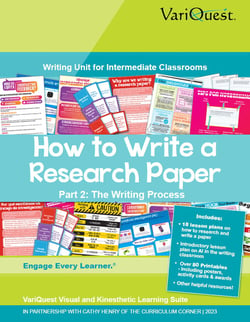
The skill of writing a research paper doesn't just develop writing skills or focus on learning more about the subject at hand. It also teaches students to gather proper information to make informed decisions when faced with options in their lives. To catapult these critical thinking skills into play, we at VariQuest have put together a substantive lesson plan unit, split into two parts (to make it easier to digest and teach!) and this second and final portion focuses on the writing (and editing) portion of the process. Get Part 1: The Research Process here!
From writing introductions and conclusions to proofreading to publishing, these lessons are designed in a writers'-workshop-style to guide students through all the important steps in writing a research paper. Using the example of The Great Barrier Reef, all lessons come paired with a handful of helpful printables - including anchor charts, discussion cards, reference pieces, and more!
Part 2 of How to Write a Research Paper explores the writing portion of the research paper process, guiding students in grades 5-7 through using the information they researched and gathered (in Part 1) to write a paper on a chosen topic, and properly cite their sources. Developed in partnership with Cathy Henry of The Curriculum Corner , students will come away with plenty of writing and editing tips, including a lesson on artificial intelligence.
In this lesson plan unit you'll find:
- Lessons 10-18 of the How to Write a Research Paper Unit focused on the writing part of the process
- Downloadable posters, activity cards, awards, & more!
- An assessment rubric to review final papers

Still need Part 1? Download that here!
Curious to learn more about how the VariQuest® Visual and Kinesthetic Learning Suite can help you save time and precious funding dollars to create lesson supports like these - from posters to bulletin board displays to study materials and more for your school? Contact us today for a no-obligation demonstration with one of our expert education consultants. You'll be amazed at what our solutions can do for you!

- USC Libraries
- Research Guides
Organizing Your Social Sciences Research Paper
- 4. The Introduction
- Purpose of Guide
- Design Flaws to Avoid
- Independent and Dependent Variables
- Glossary of Research Terms
- Reading Research Effectively
- Narrowing a Topic Idea
- Broadening a Topic Idea
- Extending the Timeliness of a Topic Idea
- Academic Writing Style
- Applying Critical Thinking
- Choosing a Title
- Making an Outline
- Paragraph Development
- Research Process Video Series
- Executive Summary
- The C.A.R.S. Model
- Background Information
- The Research Problem/Question
- Theoretical Framework
- Citation Tracking
- Content Alert Services
- Evaluating Sources
- Primary Sources
- Secondary Sources
- Tiertiary Sources
- Scholarly vs. Popular Publications
- Qualitative Methods
- Quantitative Methods
- Insiderness
- Using Non-Textual Elements
- Limitations of the Study
- Common Grammar Mistakes
- Writing Concisely
- Avoiding Plagiarism
- Footnotes or Endnotes?
- Further Readings
- Generative AI and Writing
- USC Libraries Tutorials and Other Guides
- Bibliography
The introduction leads the reader from a general subject area to a particular topic of inquiry. It establishes the scope, context, and significance of the research being conducted by summarizing current understanding and background information about the topic, stating the purpose of the work in the form of the research problem supported by a hypothesis or a set of questions, explaining briefly the methodological approach used to examine the research problem, highlighting the potential outcomes your study can reveal, and outlining the remaining structure and organization of the paper.
Key Elements of the Research Proposal. Prepared under the direction of the Superintendent and by the 2010 Curriculum Design and Writing Team. Baltimore County Public Schools.
Importance of a Good Introduction
Think of the introduction as a mental road map that must answer for the reader these four questions:
- What was I studying?
- Why was this topic important to investigate?
- What did we know about this topic before I did this study?
- How will this study advance new knowledge or new ways of understanding?
According to Reyes, there are three overarching goals of a good introduction: 1) ensure that you summarize prior studies about the topic in a manner that lays a foundation for understanding the research problem; 2) explain how your study specifically addresses gaps in the literature, insufficient consideration of the topic, or other deficiency in the literature; and, 3) note the broader theoretical, empirical, and/or policy contributions and implications of your research.
A well-written introduction is important because, quite simply, you never get a second chance to make a good first impression. The opening paragraphs of your paper will provide your readers with their initial impressions about the logic of your argument, your writing style, the overall quality of your research, and, ultimately, the validity of your findings and conclusions. A vague, disorganized, or error-filled introduction will create a negative impression, whereas, a concise, engaging, and well-written introduction will lead your readers to think highly of your analytical skills, your writing style, and your research approach. All introductions should conclude with a brief paragraph that describes the organization of the rest of the paper.
Hirano, Eliana. “Research Article Introductions in English for Specific Purposes: A Comparison between Brazilian, Portuguese, and English.” English for Specific Purposes 28 (October 2009): 240-250; Samraj, B. “Introductions in Research Articles: Variations Across Disciplines.” English for Specific Purposes 21 (2002): 1–17; Introductions. The Writing Center. University of North Carolina; “Writing Introductions.” In Good Essay Writing: A Social Sciences Guide. Peter Redman. 4th edition. (London: Sage, 2011), pp. 63-70; Reyes, Victoria. Demystifying the Journal Article. Inside Higher Education.
Structure and Writing Style
I. Structure and Approach
The introduction is the broad beginning of the paper that answers three important questions for the reader:
- What is this?
- Why should I read it?
- What do you want me to think about / consider doing / react to?
Think of the structure of the introduction as an inverted triangle of information that lays a foundation for understanding the research problem. Organize the information so as to present the more general aspects of the topic early in the introduction, then narrow your analysis to more specific topical information that provides context, finally arriving at your research problem and the rationale for studying it [often written as a series of key questions to be addressed or framed as a hypothesis or set of assumptions to be tested] and, whenever possible, a description of the potential outcomes your study can reveal.
These are general phases associated with writing an introduction: 1. Establish an area to research by:
- Highlighting the importance of the topic, and/or
- Making general statements about the topic, and/or
- Presenting an overview on current research on the subject.
2. Identify a research niche by:
- Opposing an existing assumption, and/or
- Revealing a gap in existing research, and/or
- Formulating a research question or problem, and/or
- Continuing a disciplinary tradition.
3. Place your research within the research niche by:
- Stating the intent of your study,
- Outlining the key characteristics of your study,
- Describing important results, and
- Giving a brief overview of the structure of the paper.
NOTE: It is often useful to review the introduction late in the writing process. This is appropriate because outcomes are unknown until you've completed the study. After you complete writing the body of the paper, go back and review introductory descriptions of the structure of the paper, the method of data gathering, the reporting and analysis of results, and the conclusion. Reviewing and, if necessary, rewriting the introduction ensures that it correctly matches the overall structure of your final paper.
II. Delimitations of the Study
Delimitations refer to those characteristics that limit the scope and define the conceptual boundaries of your research . This is determined by the conscious exclusionary and inclusionary decisions you make about how to investigate the research problem. In other words, not only should you tell the reader what it is you are studying and why, but you must also acknowledge why you rejected alternative approaches that could have been used to examine the topic.
Obviously, the first limiting step was the choice of research problem itself. However, implicit are other, related problems that could have been chosen but were rejected. These should be noted in the conclusion of your introduction. For example, a delimitating statement could read, "Although many factors can be understood to impact the likelihood young people will vote, this study will focus on socioeconomic factors related to the need to work full-time while in school." The point is not to document every possible delimiting factor, but to highlight why previously researched issues related to the topic were not addressed.
Examples of delimitating choices would be:
- The key aims and objectives of your study,
- The research questions that you address,
- The variables of interest [i.e., the various factors and features of the phenomenon being studied],
- The method(s) of investigation,
- The time period your study covers, and
- Any relevant alternative theoretical frameworks that could have been adopted.
Review each of these decisions. Not only do you clearly establish what you intend to accomplish in your research, but you should also include a declaration of what the study does not intend to cover. In the latter case, your exclusionary decisions should be based upon criteria understood as, "not interesting"; "not directly relevant"; “too problematic because..."; "not feasible," and the like. Make this reasoning explicit!
NOTE: Delimitations refer to the initial choices made about the broader, overall design of your study and should not be confused with documenting the limitations of your study discovered after the research has been completed.
ANOTHER NOTE: Do not view delimitating statements as admitting to an inherent failing or shortcoming in your research. They are an accepted element of academic writing intended to keep the reader focused on the research problem by explicitly defining the conceptual boundaries and scope of your study. It addresses any critical questions in the reader's mind of, "Why the hell didn't the author examine this?"
III. The Narrative Flow
Issues to keep in mind that will help the narrative flow in your introduction :
- Your introduction should clearly identify the subject area of interest . A simple strategy to follow is to use key words from your title in the first few sentences of the introduction. This will help focus the introduction on the topic at the appropriate level and ensures that you get to the subject matter quickly without losing focus, or discussing information that is too general.
- Establish context by providing a brief and balanced review of the pertinent published literature that is available on the subject. The key is to summarize for the reader what is known about the specific research problem before you did your analysis. This part of your introduction should not represent a comprehensive literature review--that comes next. It consists of a general review of the important, foundational research literature [with citations] that establishes a foundation for understanding key elements of the research problem. See the drop-down menu under this tab for " Background Information " regarding types of contexts.
- Clearly state the hypothesis that you investigated . When you are first learning to write in this format it is okay, and actually preferable, to use a past statement like, "The purpose of this study was to...." or "We investigated three possible mechanisms to explain the...."
- Why did you choose this kind of research study or design? Provide a clear statement of the rationale for your approach to the problem studied. This will usually follow your statement of purpose in the last paragraph of the introduction.
IV. Engaging the Reader
A research problem in the social sciences can come across as dry and uninteresting to anyone unfamiliar with the topic . Therefore, one of the goals of your introduction is to make readers want to read your paper. Here are several strategies you can use to grab the reader's attention:
- Open with a compelling story . Almost all research problems in the social sciences, no matter how obscure or esoteric , are really about the lives of people. Telling a story that humanizes an issue can help illuminate the significance of the problem and help the reader empathize with those affected by the condition being studied.
- Include a strong quotation or a vivid, perhaps unexpected, anecdote . During your review of the literature, make note of any quotes or anecdotes that grab your attention because they can used in your introduction to highlight the research problem in a captivating way.
- Pose a provocative or thought-provoking question . Your research problem should be framed by a set of questions to be addressed or hypotheses to be tested. However, a provocative question can be presented in the beginning of your introduction that challenges an existing assumption or compels the reader to consider an alternative viewpoint that helps establish the significance of your study.
- Describe a puzzling scenario or incongruity . This involves highlighting an interesting quandary concerning the research problem or describing contradictory findings from prior studies about a topic. Posing what is essentially an unresolved intellectual riddle about the problem can engage the reader's interest in the study.
- Cite a stirring example or case study that illustrates why the research problem is important . Draw upon the findings of others to demonstrate the significance of the problem and to describe how your study builds upon or offers alternatives ways of investigating this prior research.
NOTE: It is important that you choose only one of the suggested strategies for engaging your readers. This avoids giving an impression that your paper is more flash than substance and does not distract from the substance of your study.
Freedman, Leora and Jerry Plotnick. Introductions and Conclusions. University College Writing Centre. University of Toronto; Introduction. The Structure, Format, Content, and Style of a Journal-Style Scientific Paper. Department of Biology. Bates College; Introductions. The Writing Center. University of North Carolina; Introductions. The Writer’s Handbook. Writing Center. University of Wisconsin, Madison; Introductions, Body Paragraphs, and Conclusions for an Argument Paper. The Writing Lab and The OWL. Purdue University; “Writing Introductions.” In Good Essay Writing: A Social Sciences Guide . Peter Redman. 4th edition. (London: Sage, 2011), pp. 63-70; Resources for Writers: Introduction Strategies. Program in Writing and Humanistic Studies. Massachusetts Institute of Technology; Sharpling, Gerald. Writing an Introduction. Centre for Applied Linguistics, University of Warwick; Samraj, B. “Introductions in Research Articles: Variations Across Disciplines.” English for Specific Purposes 21 (2002): 1–17; Swales, John and Christine B. Feak. Academic Writing for Graduate Students: Essential Skills and Tasks . 2nd edition. Ann Arbor, MI: University of Michigan Press, 2004 ; Writing Your Introduction. Department of English Writing Guide. George Mason University.
Writing Tip
Avoid the "Dictionary" Introduction
Giving the dictionary definition of words related to the research problem may appear appropriate because it is important to define specific terminology that readers may be unfamiliar with. However, anyone can look a word up in the dictionary and a general dictionary is not a particularly authoritative source because it doesn't take into account the context of your topic and doesn't offer particularly detailed information. Also, placed in the context of a particular discipline, a term or concept may have a different meaning than what is found in a general dictionary. If you feel that you must seek out an authoritative definition, use a subject specific dictionary or encyclopedia [e.g., if you are a sociology student, search for dictionaries of sociology]. A good database for obtaining definitive definitions of concepts or terms is Credo Reference .
Saba, Robert. The College Research Paper. Florida International University; Introductions. The Writing Center. University of North Carolina.
Another Writing Tip
When Do I Begin?
A common question asked at the start of any paper is, "Where should I begin?" An equally important question to ask yourself is, "When do I begin?" Research problems in the social sciences rarely rest in isolation from history. Therefore, it is important to lay a foundation for understanding the historical context underpinning the research problem. However, this information should be brief and succinct and begin at a point in time that illustrates the study's overall importance. For example, a study that investigates coffee cultivation and export in West Africa as a key stimulus for local economic growth needs to describe the beginning of exporting coffee in the region and establishing why economic growth is important. You do not need to give a long historical explanation about coffee exports in Africa. If a research problem requires a substantial exploration of the historical context, do this in the literature review section. In your introduction, make note of this as part of the "roadmap" [see below] that you use to describe the organization of your paper.
Introductions. The Writing Center. University of North Carolina; “Writing Introductions.” In Good Essay Writing: A Social Sciences Guide . Peter Redman. 4th edition. (London: Sage, 2011), pp. 63-70.
Yet Another Writing Tip
Always End with a Roadmap
The final paragraph or sentences of your introduction should forecast your main arguments and conclusions and provide a brief description of the rest of the paper [the "roadmap"] that let's the reader know where you are going and what to expect. A roadmap is important because it helps the reader place the research problem within the context of their own perspectives about the topic. In addition, concluding your introduction with an explicit roadmap tells the reader that you have a clear understanding of the structural purpose of your paper. In this way, the roadmap acts as a type of promise to yourself and to your readers that you will follow a consistent and coherent approach to addressing the topic of inquiry. Refer to it often to help keep your writing focused and organized.
Cassuto, Leonard. “On the Dissertation: How to Write the Introduction.” The Chronicle of Higher Education , May 28, 2018; Radich, Michael. A Student's Guide to Writing in East Asian Studies . (Cambridge, MA: Harvard University Writing n. d.), pp. 35-37.
- << Previous: Executive Summary
- Next: The C.A.R.S. Model >>
- Last Updated: Aug 13, 2024 12:57 PM
- URL: https://libguides.usc.edu/writingguide
- U.S. Locations
- UMGC Europe
- Learn Online
- Find Answers
- 855-655-8682
- Current Students
Online Guide to Writing and Research
The research process, explore more of umgc.
- Online Guide to Writing
Planning and Writing a Research Paper
Mastering the complex academic skill of writing a research paper will prepare you to enter the discourse community of your chosen area of study with excitement and confidence. Writing a research paper can seem like a daunting task, but if you take the time in the pages ahead to learn how to break the writing process down, you will be amazed at the level of comfort and control you feel when preparing your assignment.
Mailing Address: 3501 University Blvd. East, Adelphi, MD 20783 This work is licensed under a Creative Commons Attribution-NonCommercial-ShareAlike 4.0 International License . © 2022 UMGC. All links to external sites were verified at the time of publication. UMGC is not responsible for the validity or integrity of information located at external sites.
Table of Contents: Online Guide to Writing
Chapter 1: College Writing
How Does College Writing Differ from Workplace Writing?
What Is College Writing?
Why So Much Emphasis on Writing?
Chapter 2: The Writing Process
Doing Exploratory Research
Getting from Notes to Your Draft
Introduction
Prewriting - Techniques to Get Started - Mining Your Intuition
Prewriting: Targeting Your Audience
Prewriting: Techniques to Get Started
Prewriting: Understanding Your Assignment
Rewriting: Being Your Own Critic
Rewriting: Creating a Revision Strategy
Rewriting: Getting Feedback
Rewriting: The Final Draft
Techniques to Get Started - Outlining
Techniques to Get Started - Using Systematic Techniques
Thesis Statement and Controlling Idea
Writing: Getting from Notes to Your Draft - Freewriting
Writing: Getting from Notes to Your Draft - Summarizing Your Ideas
Writing: Outlining What You Will Write
Chapter 3: Thinking Strategies
A Word About Style, Voice, and Tone
A Word About Style, Voice, and Tone: Style Through Vocabulary and Diction
Critical Strategies and Writing
Critical Strategies and Writing: Analysis
Critical Strategies and Writing: Evaluation
Critical Strategies and Writing: Persuasion
Critical Strategies and Writing: Synthesis
Developing a Paper Using Strategies
Kinds of Assignments You Will Write
Patterns for Presenting Information
Patterns for Presenting Information: Critiques
Patterns for Presenting Information: Discussing Raw Data
Patterns for Presenting Information: General-to-Specific Pattern
Patterns for Presenting Information: Problem-Cause-Solution Pattern
Patterns for Presenting Information: Specific-to-General Pattern
Patterns for Presenting Information: Summaries and Abstracts
Supporting with Research and Examples
Writing Essay Examinations
Writing Essay Examinations: Make Your Answer Relevant and Complete
Writing Essay Examinations: Organize Thinking Before Writing
Writing Essay Examinations: Read and Understand the Question
Chapter 4: The Research Process
Planning and Writing a Research Paper: Ask a Research Question
Planning and Writing a Research Paper: Cite Sources
Planning and Writing a Research Paper: Collect Evidence
Planning and Writing a Research Paper: Decide Your Point of View, or Role, for Your Research
Planning and Writing a Research Paper: Draw Conclusions
Planning and Writing a Research Paper: Find a Topic and Get an Overview
Planning and Writing a Research Paper: Manage Your Resources
Planning and Writing a Research Paper: Outline
Planning and Writing a Research Paper: Survey the Literature
Planning and Writing a Research Paper: Work Your Sources into Your Research Writing
Research Resources: Where Are Research Resources Found? - Human Resources
Research Resources: What Are Research Resources?
Research Resources: Where Are Research Resources Found?
Research Resources: Where Are Research Resources Found? - Electronic Resources
Research Resources: Where Are Research Resources Found? - Print Resources
Structuring the Research Paper: Formal Research Structure
Structuring the Research Paper: Informal Research Structure
The Nature of Research
The Research Assignment: How Should Research Sources Be Evaluated?
The Research Assignment: When Is Research Needed?
The Research Assignment: Why Perform Research?
Chapter 5: Academic Integrity
Academic Integrity
Giving Credit to Sources
Giving Credit to Sources: Copyright Laws
Giving Credit to Sources: Documentation
Giving Credit to Sources: Style Guides
Integrating Sources
Practicing Academic Integrity
Practicing Academic Integrity: Keeping Accurate Records
Practicing Academic Integrity: Managing Source Material
Practicing Academic Integrity: Managing Source Material - Paraphrasing Your Source
Practicing Academic Integrity: Managing Source Material - Quoting Your Source
Practicing Academic Integrity: Managing Source Material - Summarizing Your Sources
Types of Documentation
Types of Documentation: Bibliographies and Source Lists
Types of Documentation: Citing World Wide Web Sources
Types of Documentation: In-Text or Parenthetical Citations
Types of Documentation: In-Text or Parenthetical Citations - APA Style
Types of Documentation: In-Text or Parenthetical Citations - CSE/CBE Style
Types of Documentation: In-Text or Parenthetical Citations - Chicago Style
Types of Documentation: In-Text or Parenthetical Citations - MLA Style
Types of Documentation: Note Citations
Chapter 6: Using Library Resources
Finding Library Resources
Chapter 7: Assessing Your Writing
How Is Writing Graded?
How Is Writing Graded?: A General Assessment Tool
The Draft Stage
The Draft Stage: The First Draft
The Draft Stage: The Revision Process and the Final Draft
The Draft Stage: Using Feedback
The Research Stage
Using Assessment to Improve Your Writing
Chapter 8: Other Frequently Assigned Papers
Reviews and Reaction Papers: Article and Book Reviews
Reviews and Reaction Papers: Reaction Papers
Writing Arguments
Writing Arguments: Adapting the Argument Structure
Writing Arguments: Purposes of Argument
Writing Arguments: References to Consult for Writing Arguments
Writing Arguments: Steps to Writing an Argument - Anticipate Active Opposition
Writing Arguments: Steps to Writing an Argument - Determine Your Organization
Writing Arguments: Steps to Writing an Argument - Develop Your Argument
Writing Arguments: Steps to Writing an Argument - Introduce Your Argument
Writing Arguments: Steps to Writing an Argument - State Your Thesis or Proposition
Writing Arguments: Steps to Writing an Argument - Write Your Conclusion
Writing Arguments: Types of Argument
Appendix A: Books to Help Improve Your Writing
Dictionaries
General Style Manuals
Researching on the Internet
Special Style Manuals
Writing Handbooks
Appendix B: Collaborative Writing and Peer Reviewing
Collaborative Writing: Assignments to Accompany the Group Project
Collaborative Writing: Informal Progress Report
Collaborative Writing: Issues to Resolve
Collaborative Writing: Methodology
Collaborative Writing: Peer Evaluation
Collaborative Writing: Tasks of Collaborative Writing Group Members
Collaborative Writing: Writing Plan
General Introduction
Peer Reviewing
Appendix C: Developing an Improvement Plan
Working with Your Instructor’s Comments and Grades
Appendix D: Writing Plan and Project Schedule
Devising a Writing Project Plan and Schedule
Reviewing Your Plan with Others
By using our website you agree to our use of cookies. Learn more about how we use cookies by reading our Privacy Policy .

In order to continue enjoying our site, we ask that you confirm your identity as a human. Thank you very much for your cooperation.

IMAGES
COMMENTS
Procedure [60 minutes]: Step 1: Begin the lesson plan with an image [3 minutes] Show the third slide of the PowerPoint presentation with a picture of stacked books and an apple on the top of the book that is titled "Education.". Begin to discuss the significance of the apple as. a very powerful fruit.
From Theory to Practice. Research paper scaffolding provides a temporary linguistic tool to assist students as they organize their expository writing. Scaffolding assists students in moving to levels of language performance they might be unable to obtain without this support. An instructional scaffold essentially changes the role of the teacher ...
The research writing presentation introduces students to the eight steps for completing a research project: selecting topics, generating questions, brainstorming, researching and gathering credible information, organizing and outlining, writing the first draft, peer editing, and finalizing the paper.
The best way to teach research papers to students is by breaking down the process into manageable steps. Start with teaching them how to choose a topic, conduct research, and create an outline/list/graphic organizer. Then guide them in writing drafts, revising and editing their papers, and properly citing sources.
Lesson Ideas for Writing Research Papers: Lesson 1: Noticings. ... This graphic organizer can be used for students to plan their writing. If your writers are more advanced you might choose to skip this step, It could be a big help for students who have taken notes and have too many facts.
Read each other's syntheses, and write a thought-provoking question that asks for additional information or clarification. Return papers to one another. Read the question and write a two to three-sentence response. Continue to exchange papers, read responses, and ask another question until the time is called.
As students learn the important skill of responsibly researching for their writing, we at VariQuest have put together a 42-page booklet, split into two parts (to make it easier to digest and teach!) and this first part focuses on the research portion of the process. From choosing a topic, to learning to paraphrase, to writing a thesis, these ...
CUNY Brooklyn offers this complete lesson plan for introducing students to research papers. It includes an accompanying set of PowerPoint slides. "Lesson Plan: How to Begin Writing a Research Paper" (San Jose State Univ.) This lesson plan is designed for students in the health sciences, so teachers will have to modify it for their own needs.
Try out some of these strategies for introducing your research paper. Read the examples for ideas. Make a copy of this Google doc or download a Word template. Start with a fascinating quotation. "Do things. Be sane. Don't fritter away your time; create, act, take a place wherever you are, and be somebody; get action.". —Theodore Roosevelt ...
Part 1 of How to Write a Research Paper explores the research portion of the writing process, guiding students in grades 5-7 through independently gathering information to write a paper on a chosen topic. Developed in partnership with Cathy Henry of The Curriculum Corner, students will come away with plenty of research and sources to begin part ...
Original Research How would you test the idea you think makes the most sense? In order to test the ideas about (your topic) this researcher will (describe a suitable way to test your ideas: survey, experiment, model, interview, etc.) _____Results: (What happened?)List your results. You can attach a table, chart, or list of findings.
Our Research Writing lesson plan for grades 4-6 teaches students how to write a thoroughly researched and factually accurate five paragraph essay. Students write an essay based on research they conduct in order to practice this type of writing. Categories: Downloadable, Language Arts Tags: 4th Grade, 5th Grade, 6th Grade.
Writing a Research Report (Gr. 3) Using this writing printable, students are introduced to writing and editing a research report through this writing… Subjects:
Now play the video lesson How to Write an Outline for an Essay or Research Paper for the class, pausing at 00:53. Do any of the students know the differences between an alphanumeric outline and a ...
Develop a thesis statement. Create a research paper outline. Write a first draft of the research paper. Write the introduction. Write a compelling body of text. Write the conclusion. The second draft. The revision process. Research paper checklist.
One of the challenges of a research paper is establishing credibility. Any mistake in this area requires a penalty. Content: 10 pts. This is the opposite of what I usually do. The major objective of this assignment is to teach technical research writing skills. Once the basic skills of research writing are complete, I can then focus on content.
Unlike essays, research papers usually divide the body into sections with separate headers to facilitate browsing and scanning. Use the divisions in your outline as a guide. Follow along your outline and go paragraph by paragraph. Because this is just the first draft, don't worry about getting each word perfect.
Get Part 1: The Research Process here! From writing introductions and conclusions to proofreading to publishing, these lessons are designed in a writers'-workshop-style to guide students through all the important steps in writing a research paper. Using the example of The Great Barrier Reef, all lessons come paired with a handful of helpful ...
Flesh out the parts of a research paper by using the Writing a Research Paper: Sections & Length Lesson. Follow up this introduction by providing the components of your assessment plan, such as a ...
The introduction leads the reader from a general subject area to a particular topic of inquiry. It establishes the scope, context, and significance of the research being conducted by summarizing current understanding and background information about the topic, stating the purpose of the work in the form of the research problem supported by a hypothesis or a set of questions, explaining briefly ...
Writing a research paper can seem like a daunting task, but if you take the time in the pages ahead to learn how to break the writing process down, you will be amazed at the level of comfort and control you feel when preparing your assignment. Mailing Address: 3501 University Blvd. East, Adelphi, MD 20783. This work is licensed under a Creative ...
Writing an essay can be confusing, but with the right guide to follow there is no need to panic. Learn to write a research paper step-by-step with a process that involves determining the research ...
How to Write a Research Proposal | A Guide for Students. Published on June 22, 2024 by Paige Pfeifer, BA.Revised on August 14, 2024. A research proposal is a short piece of academic writing that outlines the research a graduate student intends to carry out. It starts by explaining why the research will be helpful or necessary, then describes the steps of the potential research and how the ...